#so i have to remember to add like. linguistic symbol. at the end
Text
little things really can make ur day. the bus was pulling into the stop and i was still across the street, where some cars were still driving so i couldn’t run across. BUT the first car saw that I needed to get on the bus and stopped for me :-) and the bus driver was closing the doors as i ran to the platform area, saw me, and reopened the doors for me :-)
#today WILL be a good day.#ð#also i kind of regret making ð my posting tag bc every time i google eth to copy it on mobile it brings up crypto shit#so i have to remember to add like. linguistic symbol. at the end
1 note
·
View note
Text
So I’m watching this YouTube documentary about the Uruk civilization (early human civilization, not… like… LotR orcs or something) and the narrator is going on about how early proto-cuneiform had different counting systems and measurements for counting different types of things. For instance, counting area (farmland, distance, the Uruk equivalent of house square-footage) would use a different counting system than counting livestock or slaves, and both of those would use a different counting system from, say, bushels of grains. The guy is making this point about how tough it would have been for clerks at the time to keep track of their records and the meaning, because they’d need to track and understand around 60 different symbols and measurements at the same time in order to understand their reports.
And I guess… I understand the point there; that sounds like a really cumbersome system, but also I can appreciate the ingenuity of that, because even if that original system was a bit clunky (and the narrator goes on to say that the system becomes more refined and adds around 500+ new symbols), the idea seems to be that with many of those, just by looking at the numeration system, the clerk would be able to tell exactly what kind of account they would be looking at. We do something similar in English with our little abbreviated measure markers at the end, like ft. and oz., and I’ll be perfectly frank, I still don’t understand all of those, but we still have a similar principle— oz are measured in sets of 16, ft in measures of 12 inches, and a whole host of other odd measurement systems! We still have varying base counting systems for different things! (Metric system enthusiasts don’t come at me I’m too enthralled in the common thread of human existence to care about base ten right now).
Anyway, apart from the point that the narrator makes about the difficulty keeping track of the different systems and the fact that many use the same symbols but mean different things, he also makes a point about how many symbols would be necessary to know for this. 60 is the number he states but I don’t know how accurate that is so we’ll just go with it. Imagine that. 60 individual symbols you need to be able to keep track of in order to read your tax returns or quarterly reports. That’s so many!!
Or is it
Because the thing I think might be getting overlooked is that we STILL have so many! Like, even just taking English again, for most of those reports you’re gonna need our alphabet and the base 10 numbering system, but let’s put THOSE aside as well, and get into the other fun stuff. Percentages? Mathematic symbols? If you’re on a spreadsheet you’re gonna be seeing a lot more of those. And let’s take this out of a purely business environment. When’s the last time that you needed to know the meaning of a bunch of individual symbols with setting-specific application and variance?
🤷
Yeah!
I don’t even want to count how many emojis we have nowadays because the number scares me and my general attitude towards technology that existed before me is a vague sense of horror and apprehension. But you get my point! Even a step more abstract, memes! The meaning of *those* is pretty obvious to anyone who is familiar enough with them, but to an outsider, or the metaphorically uninitiated, it’s nonsense and very, very confusing! (Side note: I know these are different phenomena, linguistically or whatever. I just think it’s rad and I’m making a point, ok? I took exactly 1 class on linguistics ever and I am not sure I remember a single second of it). My point is, we’ve ALWAYS had complicated systems of communication, counting, and record keeping! If you make me look at a trig problem or any level of calculus I will start crying! But my engineer friends look at that stuff and it makes perfect sense to them! If you tried to start understanding call from nothing but a few filled-out worksheets left out in the sun of COURSE it would look complicated and confusing! But it wouldn’t be for those that live and breathe this stuff.
So, at this point, I’m just equal parts delighted, encouraged, and joyous about the perpetuity of humanity’s habits and tendencies— the fact that so many things change and yet so many retain those familiar elements, resonating across the centuries and epochs of our history, and equal parts reminded (and perhaps reminding) that our ancestors were smart. Maybe they didn’t know as much raw information as we do today, but by god were they clever, and I think we forget that a lot, confusing our current level of accumulated knowledge for being bumbling idiots. No, humans are clever, more clever than we realize sometimes, and I believe that’s one of those lingering, echoing reflections of our predecessors that we still see when we look in the mirror.
#history#linguistics?#cuneiform#I’m just still riding the high of remembering#that we are humans#living in the footsteps#of people just as clever and human as us#and it’s just nice to see that sometimes
1 note
·
View note
Note
Hi! I'm very curious about something regarding the Spanish language. I'm currently studying A2 Spanish but I had this question and my teacher did not seem too willing to discuss it. Here it goes:
I know that Spanish has, something my Spanish teacher says, linguistic gender. I was wondering how do the people who don't align themselves with the gender binary (masculine and feminine) speak/write in it? I have read this article about Spanish speaking people from US adding "x" Or "@" and people from Argentina using "e" to make the words gender neutral.
Thank you so much for responding, whenever you get to it. Also love your blog. ❤
Short answer, in general speaking terms people are tending towards the -e now because the other two are very hard to actually speak, and because Spanish-speakers feel the -e is more authentic
What you're most likely to see in Spanish is masculine plural as the default, or in written things you might see todos y todas or like un/una alumno/a "a student", or like se busca empleado/a "employees wanted" / "looking for an employee"
If it's something official or academic you typically include both [todas y todas] or you go masculine plural [todos] unless it's specifically feminine plural
-
Related, linguistic gender applies to all things, not just people. Why is la mesa "table" feminine, but el libro "book" masculine? Just linguistic gender. I can tell you that most loanwords (that aren't people) in Spanish are masculine, and that there are certain words that come from Greek are masculine, and that -ista words are unisex most of the time... And I can tell you there are some words like testigo or modelo that are unisex and don't change for gender. Aside from that, speaking about nouns and grammatical gender... those particular things are harder to parse for regular people, but if you go into the field of linguistics you can explore that more deeply. Some of it is source language (i.e. "it came from Latin this way") or things like that. And in general when talking about nouns it's unimportant and not considered sexist, that's just how it is.
There is such a thing where it gets a little too far the other way and people will say "history? what about herstory" which is a nice thought but the etymology has nothing to do with gender there
When it comes to people - and when it comes to gendered attitudes - that's where it gets more confusing and more complicated.
I believe there was an experiment where people had French and Spanish speakers [I believe it was Spanish] try to identify how a "fork" would sound. French people gave it a more feminine voice because "fork" is feminine in French, while Spanish speakers gave it a more masculine voice because it's masculine in Spanish.
Whether we like it or not, certain gendered things do influence our thoughts and feelings and reactions. A similar thing in English exists where the old joke was something like "There was a car accident; a boy is rushed to the ER and the surgeon but the father was killed. When they got to the ER the doctor said 'I can't operate on him, he's my son!'" and it's like "well who could the doctor be?" ...and the doctor is his mother. We associate "doctor" as masculine and "nurse" as feminine.
There's a gender bias in our language thought patterns, even though the language changes. And that does exist in Spanish too, to different extents.
There are certain cultural and gendered stereotypes or connotations attached to certain words, many tend to be more despective or pejorative when it's women.
For example - and I know this has changed in many places or it isn't as prevalent - el jinete "horseman/rider", while the female form is la amazona "horsewoman/rider". Because la jinete or la jineta was sometimes "promiscuous woman".
There were also debates about things like la presidente vs. la presidenta or what the female version of juez should be, whether it should be la juez or la jueza
Most languages with gendered language have varying degrees of this, and all languages I'm aware of have gendered stereotypes related to professions or cultural attitudes in some way, and not just for women, and not all in the same way with some of them being very culturally based
-
The longer answer involves a bit of history, and I'll be honest, some of it is contested or considered a little controversial in Spanish-speaking countries particularly in the conservative parts (which honestly should come as no surprise)
The first symbol that I know of that came about was the X
First piece of contested history: As far as I know, it was the trans/queer and drag communities in Latin America who started the trend of X. When there were signs or bulletins that had the gendered endings - specifically masculine plural as the default plural - people would write a big X through the O. This was a way of being inclusive and also a very smash the patriarchy move.
Some people attribute this to women's rights activists which may also be true, but a good portion of the things I read from people say it was the trans/queer/drag communities in Latin America doing this.
I've also read it originated in Brazil with Portuguese; still Latin America, but not a Spanish-speaking country.
Where it's most contested is that some people will say that this trend started in the Hispanic communities of the United States. And - not without reason - people are upset that this is perceived as a very gringo movement.
That's why Latinx is considered a very American-Hispanic experience
-
The arroba (@) is relatively new. I remember seeing it in the 2000s. I don't know if it existed earlier for gender inclusivity.
People used it because it looks like a combination of O and A, so it was meant to be cut down on saying things like todos y todas or niños y niñas in informal written speech
I remember quite a few (informal) emails starting like hola tod@s or muy buenas a tod@s or things like that
I think of it more as convenience especially in the information age where you never knew who you were talking to and it's easier than including both words, especially when masculine plural might be clumsy or insensitive
Still, it's practically impossible to use the @ in spoken Spanish, so it's better for writing casually. You also likely won't be allowed to use the @ in anything academic, but in chatrooms, blogs, or forums it's an option
-
I love the E ending. And the gender neutral form in singular is elle... so it's él "he", ella "she", and elle "they (singular)"
The -e ending is I think became more common within the past 10 years though it might have existed longer than that. These sorts of changes tend to come from the queer or trans communities and tend to be more insular before becoming more of an outside thing that then the general population finds out about
It came about because there are some adjectives in Spanish that end in -e that are unisex. It's not an A, it's not an O, but it's something grammatically neutral for Spanish
It's not as awkward as X, and E exists very firmly in Spanish so it's not perceived as some outside (typically gringo) influence
The good news is, it's pretty widespread on the internet. Not so much in person (yet), but especially in Spain and Argentina at least from what I've seen, particularly in the queer communities and online culture.
The only issues with it are that for non-native speakers, you have to get used to any spelling changes. Like amigo and amiga, but to use the E ending you have to add a U... so it's amigue.
That's because there are certain words where you have to do spelling changes to preserve the sound; gue has a hard G sound like -go does [like guerra]... but ge has the equivalent of an English H sound [gelatina for example]. Another one is cómico/a "funny" which would go to cómique. Again, because co has a hard C/K sound, while ce is a soft sound more like an S or in some contexts TH/Z sound; like centro is a soft sound, while cola is a hard sound
Unless you make it to the preterite forms where you come across like pagué, alcancé, practiqué with those types of endings... or subjunctive forms, pague, alcance, practique ... Basically you'd have to be exposed to those spelling rules or you'd be really confused if you were a total beginner.
It all makes sense when you speak it, but spelling might be harder before you learn those rules
The other drawback is that the E endings are sometimes not applicable. Like in damas y caballeros "ladies and gentlemen" there's not really a gender neutral variation on that, it's all binary there. And while la caballero "female knight" does exist, you'd never see a male variation on dama; the closest I've ever seen is calling a guy a damisela en apuros "damsel in distress" in some contexts where the man needs rescuing, and it's feminine una/la damisela, and it's very tongue-in-cheek
There are also some contexts like jefe vs jefa where I guess you would say jefe for "boss" if you were going the neutral route, but it's a bit weird because it's also the masculine option.
I can't speak for how people might feel about those if they're non-binary or agender because every so often you kind of get forced into the binary whether you like it or not
I totally support the E, I just recognize there are some limitations there and it's quirks of the Spanish language itself
Important Note: Just to reiterate, E endings are the ones most Spanish-speakers prefer because it's easiest to speak and doesn't have the American connotation that X does in some circles
-
Where it gets very "Facebook comment section" is that you'll see many Latin Americans traditionalists and conservatives claim that "this is just the gringos colonizing our language" and "grammatical gender doesn't matter in Spanish". They'll say that the "gender movement" is an American feminist movement and that it's a gringo thing and doesn't reflect actual Latin Americans or Spanish-speakers
Which on the one hand, yes, English does have a lot of undue influence on other languages because of colonization, and American influence and meddling in Latin American politics is a big important issue
But as far as I'm aware of the X (and especially the E) were created by Latin Americans
The other issue I personally have is that any time this conversation comes up, someone will say something like somos latinOs and claim that masculine plural is gender neutral
To that I say, first of all, "masculine plural" is inherently gendered. Additionally, there is a gender neutral in Spanish but it's lo or ello and it's only used with "it" so it sounds very unfriendly to use on an actual person... and in plural it looks like masculine plural and everything applies like masculine plural
Second, the reason masculine plural is default is because of machismo. It's more important that we don't possibly misgender a man, so it has to be masculine plural. It's changed in some places, but growing up when I was learning Spanish, if it was 99 women and 1 man you still had to put masculine plural
I'm not opposed to there being a default, and I understand why it's easier to use masculine plural, but some people get very upset at the idea of inclusive language
...
In general, my biggest issues with these comments come when people act like non-binary/queer/trans people don't exist in Spanish-speaking countries, like English invented them somehow. So it's nice to see linguistic self-determination and seeing native speakers using the E endings.
102 notes
·
View notes
Note
Professions / job roles ending in -a or -o still vex me, in terms of gender and adjective agreement.
Which ones have both forms, depending on the person's gender, and which don't?
For ones like la guardia, which don't change form, would adjectives change? Like if you say the (male) guard is tall, would you say la guarda è alto to agree with the person's gender or la guarda è alta to agree with the form of the noun?
Same question with the polite second person Lei - if you ask "are you tired" would you always say Lei è stanca? regardless, or would you say Lei è stanco for a guy?
I know grammatical gender is not the same thing as personal gender, linguistically speaking, but having grown up speaking a language without gendered adjectives, I find this confusing.
Ciao!
Yeah I know it's kinda complicated with jobs and genders, also because there's not a rule that works all the times. We generally follow the person's gender when it comes to articles and adjectives and other parts of the speech, but as you have noticed there are exceptions. On a very general level, I can tell you from now, whenever you have doubts about the other parts of the speech, base your choices on the article. If you know the right article that goes with a noun/person, follow it with the rest as well.
Back our main problem: making the masculine and feminine of nouns in Italian is not always easy, no matter the field (I think you need to study most of them, or just read a lot of news/stuff so that you can come across the same noun many times and learn it).
Especially recently, we are introducing also the female version of some professions that once didn't have it (cause there weren't many women doing them, like for example il ministro - la ministra, il senatore - la senatrice... it's a symbol of the feminine emancipation that has started to bloom in the '80s). Ofc, these are just starting to be used nowadays and to some are still kinda weird.
Remember that some female versions of some jobs are not easy to be created (eg. il capo dipartimento -> la capo dipartimento - department chief: there's no other option than keeping the noun fixed and changing the article and the other parts of the speech)...
Professions' nouns genders it's something that is still under construction, let's say. So don't worry too much about some professions, just try to learn the more common ones or the ones you may need the most for your job, if anything. OR the ones you come across daily.
Before starting, know that I wrote something here too, and I also suggest you to take a look at the "Morfologia" section in the grammar masterpost here; but anyway:
Let's see a few examples/rules according on the suffix/endings of the profession's noun at the masculine form.
I'll try to add the exceptions if I can remember about them.
These ones only change the latter vowel; usually the masculine ends in -o/-e and the feminine in -a. The articles and adjectives and all the pronouns etc change according on the personal gender:
-aio (il fornaio -> la fornaia - baker)
-iere (il cameriere -> la cameriera - waiter/waitress)
-ino (il ballerino -> la ballerina - dancer)
A few more examples:
il cuoco -> la cuoca - chef;
l'impiegato -> l'impiegata - employee
For some nouns ending in -a/-e/-o at the masculine, the feminine suffix is -essa* (I'll mention this again soon):
il poeta -> la poetessa - poet;
il duca - la duchessa - duke;
il principe -> la principessa - prince/princess
l'avvocato -> l'avvocatessa/l'avvocato (donna)/ l'avvocata - lawyer (this is one of the new professions with the feminine corresponding noun that is kinda..."weird" as I mentioned. Think about politics and justice, for most of this type of "uncertain" nouns when it comes to turn them into feminine from masculine. It would not be too weird to still hear or use "l'avvocato" even for a woman, and add their name so to explain their personal gender - I know this doesn't sound good when it comes to people and their freedom to be who they want to be, but that's still how Italian works).
The following suffix's nouns keep a fixed form for both genders. The article though, and the other part of the speech, change according on the person's genders:
-ista (l'autista - driver, il/la chitarrista - guitarist, il/la dentista - dentist, il/la giornalista - journalist),
Let's see better: l'autista is fixed cause it starts with "a" and the only article working here is "l'"; at the plural though, it changes both article+suffix, according on the personal gender: gli autisti -m., le autiste -f.
As for the other ones: you have a fixed singular form with only the article changing according on personal gender (eg. il chitarrista, la chitarrista) and a plural form that changes article+suffix (eg. i chitarristi, le chitarriste).
-asta (il/la cineasta - film maker, il/la ginnasta - gymnast)
(Same as above, fixed singular but plural that changes according on personal genders: eg. i cineasti, le cineaste)
-e*/-nte (il/la preside - school principal, il/la cantante - singer; exceptions seen before: lo studente -> la studentessa - student; il campione -> la campionessa - champion; il vigile -> la vigilessa/la vigile - traffic policeman/woman).
Singular forms more in detail: il preside, la preside; in this case, the plural form is only one: i presidi, le presidi (only the article changes, not the suffix). For the exceptions though, the story is different: they change at the plural as well: eg. gli studenti, le studentesse.
(I didn't write fem/masc/sing/plu for all the examples, so that if you or anyone else feel like trying yourself and sending me the singular/plural, and maybe add an adjective as well, you can do that. I might even make an exercise based on this as well soon)
The following masculine suffixes have three different options for the feminine version (but for each noun there's only one valid feminine suffix, and... you need to study them to know them). Articles and all the part of the speech change according on the person's gender, and also the plurals change form.
-tore can turn into:
-> -trice (l'attore -> l'attrice - actor/actress; il pittore -> la pittrice - painter/paintress, il doppiatore -> la doppiatrice - dubber, l'ispettore -> l'ispettrice -inspector)
(eg. plural: gli attori-> le attrici)
-> -a (il tintore -> la tintora -dyer)
(eg. plural: i tintori, le tintore)
-> -essa* (il dottore -> la dottoressa - doctor)
(eg. plural: i dottori, le dottoresse);
-sore can turn into
-> -itrice (il difensore -> la difenditrice - defensor)
-> -essa (il professore -> la professoressa - professor)
-> -a* (l'assessore -> l'assessora - assessor; another one of the politics/justice nouns related I mentioned)
For fixed professions names as "guardia", we generally tend to keep the accordance of the adjective with the noun (as you do with the article: you always say "la guardia" and never "il guardia" if it's a man. I confirm what I said in the beginning: try to go according on the article whenever you have doubts about the other parts of the speech.) So yeah: "la guardia è alta", even if it's a man. Tbh, there's this "fun" side note about this specific noun that is: to be formal and respectful, you could even address to them as "Signora guardia!" which honestly used to make male security guards feel very bad. So I don't suggest you to say this for real, I'm just saying that it'd be grammatically correct to keep it feminine with a man too. The plural for this comes in only one form: le guardie.
eg. La guardia del corpo, le guardie del corpo. That's why we tend to use the English version "bodyguard" as well: no need to use the feminine and make them feel "any less", ig.. sorry.
Many times, as I mentioned in the begining of this answer, it's not easy to say if a feminine version of a name might work or not. But it happens also with some masculine names as well. There are semantic reasons (eg. il canottiere - rower -> la canottiera, the feminine version for us translates as "undershirt" mostly, so it's not really appropriate, we don't use it), or some forms that hide the genders anyway (like we saw for "l'autista" and like it could be for "l'ufficiale" - official); there are also many professions that we historically still perceive for a specific gender and may sound weird in a different one (eg. il muratore -> la muratora? - construction worker; la crocerossina -> il crocerossino? - red cross nurse) and so the other gender version is kinda blocked. Whenever there's a doubt and we have no certainty about the existance of a specific profession's gender noun, we tend to keep the noun fixed and change the article+other parts of the speech or say something like "la donna + masculine profession" (eg. la donna soldato = the woman soldier, despite la soldatessa works good nowadays, I mean, it's used...).
Yes, use the masculine if you're talking with a guy.
In the specific case you mentioned for the formal speech, you can even leave the subject implied (you're talking directly to that person, so there's no need to keep repeating "Lei" at the start of every sentence), and just ask: "è stanco?" (or you can use a gender-free question: "si sente bene?" "tutto bene?" "sta bene?").
I feel the most important thing that works as the formal respectful way to address to someone is the verb at the 3rd singular person. So try to focus on that mostly. And yes, the subject is always "Lei" both for guys and girls, the other parts of the speech change according on the personal gender of the person you're talking to (basically, instead of using the informal "tu sei/hai" = you are/have; you turn all into a formal "lei è/ha" = he/she is/has, as if you were talking with your friend about another person, but you're actually talking to that 3rd person... ?? If this makes sense!).
Let's make another example with the use of Lei (not implied) though. Let's suppose you're in a meeting with someone (a guy) and you end up talking about your summer vacations. They have asked you about yours, so once you're done, you want to ask them the same. You can say: "Lei è stato al mare, invece?"
Sorry if I wrote this much. I hope it's clear enough and you have found at least some answers to your questions. If not, drop another ask, I'll try my best to reorganize my thoughts and be more accurate (the heat is making it difficult for me to even speak my native language so please forgive me for any mistakes here - okay I'd make mistakes anyway but shhh)
#it#italian#italiano#langblr#italian language#italian langblr#language#grammatica italiana#italian grammar#parole words#lingua italiana#nouns gender#italian nouns gender#italianblr#languageblr#languages#italian professions#formal italian speech#formal speech
11 notes
·
View notes
Text
Sora/Kairi in KH3 - Conversation with Chirithy Scene

This is the fourth in a series of translation posts I’ve done about Sora and Kairi’s scenes in KH3. The first post about the paopu fruit sharing scene can be found here, the second post about the light in the darkness scene can be found here, and the third post about Sora’s speech before he saves Kairi can be found here.
Here’s a general key for the kind of analysis I like to do:
JP: Official Japanese Dialogue
EN: Official English Dialogue
TR: My Translation (usually more literal and thus more stilted than the official English version. I’m not using natural-sounding English in order to stick as close to the Japanese versions of the lines as possible for the purpose of analysis)
Notes: things I found interesting, grammatical points, extra thoughts, etc.
One last note: media doesn’t exist in a vacuum. Every work of art is influenced by other art and by the cultural background of the people who made it. Kingdom Hearts, for all its ties to Disney, is still very much a Japanese game, so it should be analyzed in light of that.
With that in mind, let’s continue.
Sora and Kairi arrive at the Final World, which earlier Sora described as the world of ocean and sky. One possible reading of the kai part of Kairi’s name, as many of you know, can mean ocean/sea, 海, and Sora’s name can be read as sky, 空. They’re visiting a world that has a lot of symbolic significance for their names, and they’re here together, which perhaps Sora’s words hinted at all along.
Notice how Sora carefully holds onto Kairi as they land, and she likewise has her hand resting on his side. At first they seem surprised/unsure...

...and then their expressions change to joy as they admire the view around them:

They look at each other as if to share this moment together. Sora offers Kairi his hand, and she takes it as they float to the ground:


Then they land, though there is no ground here, just water. It is the world of ocean and sky, after all. The camera focuses on their feet to draw attention to the fact that this isn’t a normal world; only water and sky exist as far as the eye can see. Notice how Kairi positions her feet with her toes pointed slightly inward. This is considered cute and ladylike in Japan, and Kairi poses like this to give hints about her character to the audience. Notice how Sora’s toes point outwards to indicate a more masculine stance:

The medium close-up shot here frames Kairi’s reaction to the Final World, allowing the audience to empathize with her and take in her reaction to her surroundings:


Note the look of joy and wonder on her face:

Next, we get this long shot/wide shot of the two of them, still holding hands, to emphasize the vastness of the Final World and how amazed they are by the sheer size of the place:

The camera even zooms out to emphasize how small they are compared to how big the Final World is:

We go back to a medium shot of Kairi as she continues to admire the view. Again, this experience is framed in terms of her wonder and joy:

And then Sora enters the frame...

...but the focus is still on Kairi...

...as he gazes at her in a way that can best be described as adoring:

JP きれいー
EN It’s so pretty...
TR It’s so prettyー
Notes: The Japanese version has Kairi drop the copula da after “pretty,” probably so that she will sound more feminine. The English version picks up on this and has Kairi say “so,” which is more common in feminine speech than in masculine speech.
Sora continues to admire Kairi, even though he’s in such a beautiful place. Kairi is what draws his attention despite the stunning view around them. She’s more beautiful to him than anything else, and everything else fades away in importance for him:

His eyebrows even relax a little and his eyes do this affectionate squint almost, just to show how comfortable he feels around her and to indicate his feelings for her:

The camera focuses more on him in this shot, a clue that we’re supposed to pay attention to what he’ll do next:

We see the same eyebrow relaxing and eye squinting that happened earlier:

And then something else catches his attention, and his expression sobers considerably. There is sadness in his eyes, even at a happy time like this:

The camera cuts to his hand, which, as we can see, is starting to fade out of existence. The shot is from his POV here, indicating we’re experiencing what’s happening through his eyes:

He spreads his palm out as his entire hand goes translucent:

But only temporarily, as it becomes solid again as he watches:

Next we get this low angle shot of Sora reacting to the change, probably to include both his hand and his face in the shot. Still, it’s interesting that this choice of shot was used, because usually it’s used to emphasize power dynamics. Perhaps it is done here to make Sora seem larger-than-life? His breath catches here as well in both the English and the Japanese versions:

Sora curls his fingers here...

...and makes a fist. Note the look of resignation/determination on his face:

Then he turns to Kairi:

He doesn’t dwell on what’s happening and doesn’t feel sorry for himself. No, his concern is with Kairi and with getting her home:

JP カイリ
EN Kairi.
TR Kairi
Notes: Nothing really to note here, Sora just says her name to get her attention. He says her name frequently in Re:Mind, almost as if he’s waiting for every possible excuse to say it.
This next frame shows the two of them about equally, to indicate the focus is on both of them now:

JP 帰ろう みんなが待ってる
EN Come on. Everyone’s waiting.
TR Let’s go home. Everyone’s waiting.
Notes: The intonation for both the English and Japanese versions are pretty similar here. Sora’s voice falls on both sentences to indicate he isn’t asking a question, he’s suggesting what they do next. He uses casual forms of the verbs because he and Kairi are comfortable with each other and know each other well. The verb for “go home,” kaeru, is often used to indicate returning to one’s home, so it’s clear he wants to take her back to Destiny Islands like he promised he would.
Next, we get a shot focusing on Kairi’s face and reaction:

JP うん
EN (Kairi just makes an affirmative noise in the English version)
TR Okay
Notes: Kairi agrees to Sora’s suggestion and nods.
Her eyes also do the same affectionate squint that Sora’s did earlier when he looked at her. They’re mirroring each other’s body language:


Then we get this shot to show Sora’s reaction to her, and look at the love in his eyes:

Then he smiles this precious smile that also strikes me as deeply sad, in a way. I don’t know if that was intentional, but considering how his fate must be weighing on his mind and how hard he’s trying to make sure Kairi’s having a good time, it might very well be on purpose. It’s also a very brief smile in comparison to some of his other smiles and strikes me as a little forced for that reason:

Notice again how his smile isn’t really reaching his eyes. They’re open too wide in comparison to his earlier, genuine smiles:

Though his expression here does seem happier/more content, now that he’s smiling more naturally:

Then he remembers Chirithy:

JP あっ!
EN (Sora just makes a surprised noise in the English version, like he’s suddenly remembering something)
TR Oh!
Notes: Pretty similar in both versions; Sora’s expressing that he just remembered Chirithy.
He looks around...

...and the camera cuts to a shot of Kairi watching him look around:

She even leans forward a little to try to meet his gaze...

...and asks him a question:

JP どうしたの?
EN What’s wrong?
TR What’s wrong?
Notes: Sora murmurs ええと to himself right before Kairi asks him what’s wrong, and he says “uh” in the English version. Pretty similar in meaning to one another, and it shows the localization team’s attention to detail.
Kairi uses the particle no at the end of her statement in Japanese along with rising intonation to indicate she’s asking a question. In the English version, she just uses rising intonation and the fronting of the wh-word “what” to do so. She asks the same thing in both languages, just uses slightly different linguistic tools to do so.
We get this full shot of the two of them to show that Chirithy is nowhere to be found:

JP うん 友達がいるはずなんだけどー
EN Well... My friend should be here, but...
TR Well, (my) friend is supposed to be here, butー
Notes: The Japanese and English versions are pretty similar here. Sora uses hazu to indicate that he expected Chirithy to be here, that Chirithy was supposed to be here, but for whatever reason, his friend isn’t showing up. Note though how “my” is assumed from context in the Japanese version and explicitly spelled out in the English version. Japanese can drop pronouns in a lot of instances where they are obligatory in English.
Sora looks around with a hand to his forehead:

In multiple directions:

And then calls out to Chirithy as Kairi calmly watches, heightening the humor of the scene:

JP おーい チリシィー!
EN Heeey! Chirithy!
TR Heeey! Chirithyー!
Notes: Again, the English and Japanese versions are pretty much the same. Sora drags out the vowel in both languages as he calls out to Chirithy.
Then we get this odd shot of part of Sora’s leg. Our brains work slightly ahead of the scene...

...and poof, Chirithy shows up right by Sora, again heightening the humor of the scene because we expected this to happen a split second before it did. Chirithy’s incredibly unimpressed expression likewise adds to the humor:

The scene cuts to a long shot of the three of them, Kairi and Chirithy calm while Sora is shocked, which once again adds to the humor of the scene:

Note Sora’s defensive stance here, because his body quickly reacted to his surprise:

JP 何だよ そばにいたのか
EN Whoa! Hey, why didn’t you say something?
TR What the heck? (You) were here (this whole time)?
Notes: In the English version, Sora sounds more surprised in the first sentence, but in the Japanese version, he just sounds irritated, haha. Granted, he also shows some irritation in the second sentence in the English version, so the overall gist is the same. In the Japanese version, he also uses ~dayo after nan to emphasize his irritation, and ~noka at the end of the second sentence to ask a question and make it clear he wants an explanation from Chirithy.
Notice how in this shot his hands change position to emphasize his desire for an explanation:

Next we get a shot of Chirithy at a bit of a high angle, probably to emphasize Chirithy’s cuteness and vulnerability:

JP ボクだって一応気つかってるんだから
EN I was just trying to give you some privacy.
TR I was just trying to be considerate (lit. Because even I’m [a little] aware/Because even I can be [a little] considerate/thoughtful).
Notes: Chirithy uses an interesting variation of the pronoun boku here. Normally, boku is written in kanji, but here it’s written in katakana, and I’m not entirely sure why. Maybe to make Chirithy sound different or unique?
Anyway, since Sora wanted answers, Chirithy uses the ~ndakara pattern to provide an explanation. Chirithy’s answer is also snarky as all get out in both languages, and it’s really emphasized by the tone of voice and grammar Chirithy uses. I had a little trouble translating Chirithy’s words here and maintaining a balance between a more literal reading and a more “basic gist” meaning. Part of it is because I still have trouble parsing certain formulaic expressions, which is what I’m gathering this one is. But the basic idea is that Chirithy is saying “Yeah okay, even I know when to give you some space, I can be considerate and thoughtful when I need to be, you know.”
Sora and Kairi look at each other and chuckle, but note how they are not denying what Chirithy said. They’re not all that embarrassed, either. This is a huge change from Sora turning bright red and denying Donald and Goofy when they teased him about his crush on Kairi in KH2. Now, he’s comfortable with the idea of the two of them being seen as a couple, with other people giving them privacy, because that’s the sort of thing couples want:

If anything, the way Sora scratches his head screams “Haha oops, guilty as charged, I was definitely enjoying being alone with you, Kairi”:

Kairi, as polite and friendly as always, moves to introduce herself to Chirithy. Note how the angle is low to highlight the size difference between Sora and Kairi vs. Chirithy:

But Kairi bends down so she’s closer to Chirithy’s level and offers her hand. This is really similar to what Sora does to show empathy to his smaller friends, and it’s adorable that Kairi does it too. They share a lot in common, and it really shows, even in the little things. It also shows how kind and caring Kairi is, because she’s treating Chirithy like an equal. True Disney Princess right here, befriending all the critters she runs across:

JP はじめまして
EN Nice to meet you.
TR Nice to meet you
Notes: Kairi initiates the set expression used to start an introduction in Japanese, hajimemashite. This phrase also often gets translated as “How do you do?”, but interestingly enough, it’s a conjugation of the verb for “to begin.” It’s just one of those set phrases that has a different everyday meaning than its literal meaning.
The camera shot changes, and we see a full shot with Kairi reaching out to Chirithy as Chirithy tentatively offers its paw:


They shake hands, and Chirithy returns the greeting:

JP あっ はじめまして 無事でよかった
EN Oh, likewise! I’m glad you’re okay.
TR Oh, nice to meet you too! I’m glad you’re safe.
Notes: Chirithy lets out a little expression of surprise, then returns Kairi’s hajimemashite. Chirithy also expresses relief that Kairi is okay using bujideyokatta. Buji can mean several things, which is why I translated it as “safe” and why the official English version went with “okay.”
The next shot is of Sora and Kairi, emphasizing how Sora is about to speak:

Sora bends down a little in the same empathetic gesture he’s used before and Kairi used in this scene to help Chirithy feel more at ease:

JP でさ 俺たち帰るんだけど チリシィもいっしょに来なよ
EN Chirithy, we’re heading home. You should come with us.
TR So, we’re heading home, but you (lit. Chirithy) should come with us.
Notes: Main thing to note here is that Japanese tends to use names when English would use pronouns. Sora uses ore to refer to himself, so it’s no surprise he uses the plural form oretachi to refer to both him and Kairi. His suggestion is worded a bit more strongly than a regular request with the use of the particle yo.
Chirithy is shocked by the proposition, and we get a shot to its reaction that’s almost at eye level to put the focus on Chirithy’s feelings:

Chirithy staggers back slightly and expresses its incredulity:

JP えええー!
EN Whaaat...?
TR Huuuh?!
Notes: Much like with Sora’s “heeey,” the vowels here are also elongated for emphasis in both Japanese and English.
We get a shot of Sora talking to Chirithy here that includes Kairi as well:

JP やっぱりさ 会いたい人を待つだけじゃダメなんだ
EN Take it from me, it’s not enough to wait for someone you care about.
TR All the same, just waiting for the person you want to meet is no good.
Notes: “All the same” isn’t necessarily the best translation here, and I much prefer the English version’s “Take it from me.” Yappari just has a lot of possible meanings, and the best way to translate it depends on context, and I’m struggling a bit here.
“Someone you care about” is literally “(the) person (you) want to meet” in Japanese. Rendering it literally would sound awkward in English, though, so the translators went with something that sounds much more natural in English.
We get a medium shot of Sora here to emphasize his next words, which are about the heart:

JP 離れていても確かに心は繋がってる
EN It’s true that hearts are connected wherever you are.
TR Even when (they)’re separated, hearts are absolutely connected.
Notes: “Connecting hearts is my power,” is Sora’s motto in Japanese, so it’s not a surprise that he reference heart connections here. And the “even when hearts are separated” language is very, very similar to things Sora has said to Kairi in the past. This scene in KH1 comes to mind:

JP カイリ 離れても僕らはもうひとりじゃない
EN Kairi, even if we’re apart, we’re not alone anymore.
TR Kairi, even if we’re separated, we’re not alone.
Before, Sora was okay with being apart from Kairi, because it was enough that their hearts were connected.
Well, that’s changed. Being apart from her isn’t acceptable to him anymore. It’s not enough that their hearts are connected; he actually wants to be by her side. That’s his priority now.
He makes a fist to indicate he truly believes what he’s saying:

Look at his expression of peace and confidence:

We get this shot of Kairi listening intently to his words as he continues. It’s clear she thinks highly of his opinions, and much like he admired her earlier, she admires him here:

JP どうしてもそばにいられないなら その時を待つのも仕方ない
EN If it’s impossible to be together, then all you can do is wait.
TR If you can’t be together at all, then all you can do is wait (for that time).
Notes: I’m a little shaky on the “for that time” bit, because I think it’s supposed to mean “all you can do is wait for when you can be together again,” but I’m not 100% sure. Anyway, “be together,” sobaniiru, is more literally “be by (each other’s) sides, but “be together” sounds more natural in English.
Sora also uses the common expression shikatanai to indicate sometimes it can’t be helped, all you can do is wait. Shikatanai is a very common phrase that’s useful in a wide variety of situations, so if you’re learning Japanese, that’s a good one to remember.
The next shot is a high angle centered on Chirithy. We saw Kairi’s reaction to Sora’s words, and now we get to watch Chirithy’s:

JP でも もし そばにいられるなら そばにいたほうがいい
EN But, if it is possible for you to be together, then that’s how it should be.
TR But, if you can be together, it’s better to be together.
Notes: Sora uses the ~hōgaii construction to give Chirithy advice here.

JP ソラー
EN Sora...
TR Soraー
Notes: No differences really, Chirithy just says Sora’s name.
Then we get this full shot of the three of them again to draw our attention to the beauty of the Final World:

JP ここはさ 確かにきれいな場所だけど 一人で見るより大事な人といっしに見たほうがいい
EN You know, this really is a beautiful place. But you’d enjoy it so much more with someone you care about.
TR This place really is beautiful. But it’s better to see it with someone important to you (lit. an important person) than it is to see it alone.
Notes: To avoid having my translation be really choppy, I reordered the words a bit. But in the Japanese version, Sora says something more like “Here (emphasis), is a really pretty place but,” if I were to transcribe it more literally. He also contrasts seeing this place alone (which is nice enough, and which he has done) to seeing it with someone you care about (which he has also done), literally daijinahito in Japanese. The latter is far preferable in his eyes, and he once again gives Chirithy advice using ~hōgaii.
Next, we get this shot of Sora to draw attention to what he does next...

...which is look at Kairi. He says these words, he talks about how important it is to spend time with someone who is precious to you, and it’s clear from his body language who he considers important:

He smiles as Kairi turns her head to look at him:

JP さっき カイリといっしょに見て思った
EN Before, when I was looking around with Kairi,
TR Earlier, when I was looking around with Kairi, I thought
Notes: We get a better idea of what was going through Sora’s head earlier as he gazed lovingly at Kairi and only briefly looked at the scenery.
Kairi looks at him...

...they share a moment...

...and then Sora explains to Chirithy what he thought about:


JP 何かを共有しあうのも時には大事なことなんだ
EN I remembered how important it is... to share moments with friends.
TR Sometimes it’s important to share some things (with someone else/with each other).
Notes: When Sora looked at Kairi earlier, he realized how important it is (again, the word daiji is used here, paralleling the use of daiji earlier) to share things with her. He is, by extension, generalizing that advice to Chirithy to get Chirithy to agree to go home to Ven.
And because it has to be said... (insert deep sigh here...) there is no mention of “friends” in the Japanese version. The English version probably added it in because the sentence would’ve sounded too vague and unnatural in English, which you can see by my more literal “sometimes it’s important to share some things (with each other).” Do you know anyone who talks that vaguely? Exactly.
This is not “proof” Sora friendzoned Kairi in the English version either. He is taking an empathetic stance and is relating his situation with Kairi to Chirithy’s situation with Ven. Obviously, Sora’s bond with Kairi is different from Chirithy’s with Ven, but what they share in common is that they consider the other person important. And of course Sora would consider Kairi his friend; that’s the foundation of any good romantic relationship. Just because he calls her his friend in the English version does not mean that’s all he sees her as (clearly, as he keeps looking at her lovingly throughout this whole scene). Besides, either the English version of the games gets priority in terms of interpretation, or the Japanese version does (or you take a third option and use both to interpret scenes). Consistency is key here, and all I ask is that other people translating and interpreting these scenes give a fair shake to both versions instead of cherry picking which one suits their narrative better.
Anyway, continuing on.
Sora finishes his speech, and the focus is once again on Chirithy:

JP だから いっしょにここを出て チリシィの友達のところに連れて行くよ
EN That’s why you’re coming with us. I’m taking you to see your friend, Chirithy.
TR That’s why (you)’re leaving this place with us. We’ll take you to your (lit. Chirithy’s) friend.
Notes: “Friend” pops up here in the English version, but only in reference to Chirithy’s friend, aka Ven. The Japanese version uses “Chirithy’s friend” because again, names are more commonly used than pronouns, whereas in English, the opposite is true. Also, Sora ends his statement with the particle yo to give it a little more emphasis.
Chirithy is so touched that it starts crying over Sora’s kind offer:

And then Chirithy agrees and bows:

JP うん
EN (Sobbing noises)
TR Okay
Kairi likewise nods to show her agreement:

And then we get this shot of Sora and Kairi from Chirithy’s POV:

They smile at Chirithy, and Sora offers his hand, just like he did to Aqua earlier in the game. Notice how they both bend down a little to once again bring themselves closer to Chirithy’s level:

JP よし 行こう!
EN Okay! Let’s go!
TR Okay, let’s go!
Notes: Pretty straightforward meaning, no additional comments here.
And that’s a wrap! The scene fades to white:

Thank you for taking the time to read! Screenshots are from here. General disclaimer about how my Japanese abilities are a work in progress, same with my translation abilities, and I’m working on learning how to do more film analysis type things. The guides here and here were excellent references for different types of camera angles and shots.
#sokai#re:mind#re:mind spoilers#kh3#kh3 spoilers#kingdom hearts#kingdom hearts 3#kingdom hearts 3 spoilers#kh translation#kh analysis#phoenix plays kh3#sora#kairi#chirithy#phoenix downer#phoenix translates#long post
209 notes
·
View notes
Photo

Language supermodel: How GPT-3 is quietly ushering in the A.I. revolution https://ift.tt/3mAgOO1

OpenAI
OpenAI’s GPT-2 text-generating algorithm was once considered too dangerous to release. Then it got released — and the world kept on turning.
In retrospect, the comparatively small GPT-2 language model (a puny 1.5 billion parameters) looks paltry next to its sequel, GPT-3, which boasts a massive 175 billion parameters, was trained on 45 TB of text data, and cost a reported $12 million (at least) to build.
“Our perspective, and our take back then, was to have a staged release, which was like, initially, you release the smaller model and you wait and see what happens,” Sandhini Agarwal, an A.I. policy researcher for OpenAI told Digital Trends. “If things look good, then you release the next size of model. The reason we took that approach is because this is, honestly, [not just uncharted waters for us, but it’s also] uncharted waters for the entire world.”
Jump forward to the present day, nine months after GPT-3’s release last summer, and it’s powering upward of 300 applications while generating a massive 4.5 billion words per day. Seeded with only the first few sentences of a document, it’s able to generate seemingly endless more text in the same style — even including fictitious quotes.
Is it going to destroy the world? Based on past history, almost certainly not. But it is making some game-changing applications of A.I. possible, all while posing some very profound questions along the way.
What is it good for? Absolutely everything
Recently, Francis Jervis, the founder of a startup called Augrented, used GPT-3 to help people struggling with their rent to write letters negotiating rent discounts. “I’d describe the use case here as ‘style transfer,'” Jervis told Digital Trends. “[It takes in] bullet points, which don’t even have to be in perfect English, and [outputs] two to three sentences in formal language.”
Powered by this ultra-powerful language model, Jervis’s tool allows renters to describe their situation and the reason they need a discounted settlement. “Just enter a couple of words about why you lost income, and in a few seconds you’ll get a suggested persuasive, formal paragraph to add to your letter,” the company claims.
This is just the tip of the iceberg. When Aditya Joshi, a machine learning scientist and former Amazon Web Services engineer, first came across GPT-3, he was so blown away by what he saw that he set up a website, www.gpt3examples.com, to keep track of the best ones.
“Shortly after OpenAI announced their API, developers started tweeting impressive demos of applications built using GPT-3,” he told Digital Trends. “They were astonishingly good. I built [my website] to make it easy for the community to find these examples and discover creative ways of using GPT-3 to solve problems in their own domain.”
Fully interactive synthetic personas with GPT-3 and https://t.co/ZPdnEqR0Hn ????
They know who they are, where they worked, who their boss is, and so much more. This is not your father's bot… pic.twitter.com/kt4AtgYHZL
— Tyler Lastovich (@tylerlastovich) August 18, 2020
Joshi points to several demos that really made an impact on him. One, a layout generator, renders a functional layout by generating JavaScript code from a simple text description. Want a button that says “subscribe” in the shape of a watermelon? Fancy some banner text with a series of buttons the colors of the rainbow? Just explain them in basic text, and Sharif Shameem’s layout generator will write the code for you. Another, a GPT-3 based search engine created by Paras Chopra, can turn any written query into an answer and a URL link for providing more information. Another, the inverse of Francis Jervis’ by Michael Tefula, translates legal documents into plain English. Yet another, by Raphaël Millière, writes philosophical essays. And one other, by Gwern Branwen, can generate creative fiction.
“I did not expect a single language model to perform so well on such a diverse range of tasks, from language translation and generation to text summarization and entity extraction,” Joshi said. “In one of my own experiments, I used GPT-3 to predict chemical combustion reactions, and it did so surprisingly well.”
More where that came from
The transformative uses of GPT-3 don’t end there, either. Computer scientist Tyler Lastovich has used GPT-3 to create fake people, including backstory, who can then be interacted with via text. Meanwhile, Andrew Mayne has shown that GPT-3 can be used to turn movie titles into emojis. Nick Walton, chief technology officer of Latitude, the studio behind GPT-generated text adventure game AI Dungeon recently did the same to see if it could turn longer strings of text description into emoji. And Copy.ai, a startup that builds copywriting tools with GPT-3, is tapping the model for all it’s worth, with a monthly recurring revenue of $67,000 as of March — and a recent $2.9 million funding round.
“Definitely, there was surprise and a lot of awe in terms of the creativity people have used GPT-3 for,” Sandhini Agarwal, an A.I. policy researcher for OpenAI told Digital Trends. “So many use cases are just so creative, and in domains that even I had not foreseen, it would have much knowledge about. That’s interesting to see. But that being said, GPT-3 — and this whole direction of research that OpenAI pursued — was very much with the hope that this would give us an A.I. model that was more general-purpose. The whole point of a general-purpose A.I. model is [that it would be] one model that could like do all these different A.I. tasks.”
Many of the projects highlight one of the big value-adds of GPT-3: The lack of training it requires. Machine learning has been transformative in all sorts of ways over the past couple of decades. But machine learning requires a large number of training examples to be able to output correct answers. GPT-3, on the other hand, has a “few shot ability” that allows it to be taught to do something with only a small handful of examples.
Plausible bull***t
GPT-3 is highly impressive. But it poses challenges too. Some of these relate to cost: For high-volume services like chatbots, which could benefit from GPT-3’s magic, the tool might be too pricey to use. (A single message could cost 6 cents which, while not exactly bank-breaking, certainly adds up.)
Others relate to its widespread availability, meaning that it’s likely going to be tough to build a startup exclusively around since fierce competition will likely drive down margins.

Christina Morillo/Pexels
Another is the lack of memory; its context window runs a little under 2,000 words at a time before, like Guy Pierce’s character in the movie Memento, its memory is reset. “This significantly limits the length of text it can generate, roughly to a short paragraph per request,” Lastovich said. “Practically speaking, this means that it is unable to generate long documents while still remembering what happened at the beginning.”
Perhaps the most notable challenge, however, also relates to its biggest strength: Its confabulation abilities. Confabulation is a term frequently used by doctors to describe the way in which some people with memory issues are able to fabricate information that appears initially convincing, but which doesn’t necessarily stand up to scrutiny upon closer inspection. GPT-3’s ability to confabulate is, depending upon the context, a strength and a weakness. For creative projects, it can be great, allowing it to riff on themes without concern for anything as mundane as truth. For other projects, it can be trickier.
Francis Jervis of Augrented refers to GPT-3’s ability to “generate plausible bullshit.” Nick Walton of AI Dungeon said: “GPT-3 is very good at writing creative text that seems like it could have been written by a human … One of its weaknesses, though, is that it can often write like it’s very confident — even if it has no idea what the answer to a question is.”
Back in the Chinese Room
In this regard, GPT-3 returns us to the familiar ground of John Searle’s Chinese Room. In 1980, Searle, a philosopher, published one of the best-known A.I. thought experiments, focused on the topic of “understanding.” The Chinese Room asks us to imagine a person locked in a room with a mass of writing in a language that they do not understand. All they recognize are abstract symbols. The room also contains a set of rules that show how one set of symbols corresponds with another. Given a series of questions to answer, the room’s occupant must match question symbols with answer symbols. After repeating this task many times, they become adept at performing it — even though they have no clue what either set of symbols means, merely that one corresponds to the other.
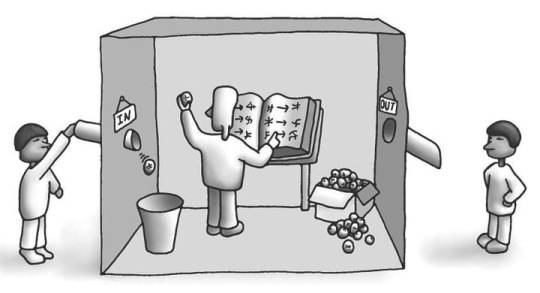
GPT-3 is a world away from the kinds of linguistic A.I. that existed at the time Searle was writing. However, the question of understanding is as thorny as ever.
“This is a very controversial domain of questioning, as I’m sure you’re aware, because there’s so many differing opinions on whether, in general, language models … would ever have [true] understanding,” said OpenAI’s Sandhini Agarwal. “If you ask me about GPT-3 right now, it performs very well sometimes, but not very well at other times. There is this randomness in a way about how meaningful the output might seem to you. Sometimes you might be wowed by the output, and sometimes the output will just be nonsensical. Given that, right now in my opinion … GPT-3 doesn’t appear to have understanding.”
An added twist on the Chinese Room experiment today is that GPT-3 is not programmed at every step by a small team of researchers. It’s a massive model that’s been trained on an enormous dataset consisting of, well, the internet. This means that it can pick up inferences and biases that might be encoded into text found online. You’ve heard the expression that you’re an average of the five people you surround yourself with? Well, GPT-3 was trained on almost unfathomable amounts of text data from multiple sources, including books, Wikipedia, and other articles. From this, it learns to predict the next word in any sequence by scouring its training data to see word combinations used before. This can have unintended consequences.
Feeding the stochastic parrots
This challenge with large language models was first highlighted in a groundbreaking paper on the subject of so-called stochastic parrots. A stochastic parrot — a term coined by the authors, who included among their ranks the former co-lead of Google’s ethical A.I. team, Timnit Gebru — refers to a large language model that “haphazardly [stitches] together sequences of linguistic forms it has observed in its vast training data, according to probabilistic information about how they combine, but without any reference to meaning.”
“Having been trained on a big portion of the internet, it’s important to acknowledge that it will carry some of its biases,” Albert Gozzi, another GPT-3 user, told Digital Trends. “I know the OpenAI team is working hard on mitigating this in a few different ways, but I’d expect this to be an issue for [some] time to come.”
OpenAI’s countermeasures to defend against bias include a toxicity filter, which filters out certain language or topics. OpenAI is also working on ways to integrate human feedback in order to be able to specify which areas not to stray into. In addition, the team controls access to the tool so that certain negative uses of the tool will not be granted access.
“One of the reasons perhaps you haven’t seen like too many of these malicious users is because we do have an intensive review process internally,” Agarwal said. “The way we work is that every time you want to use GPT-3 in a product that would actually be deployed, you have to go through a process where a team — like, a team of humans — actually reviews how you want to use it. … Then, based on making sure that it is not something malicious, you will be granted access.”
Some of this is challenging, however — not least because bias isn’t always a clear-cut case of using certain words. Jervis notes that, at times, his GPT-3 rent messages can “tend towards stereotypical gender [or] class assumptions.” Left unattended, it might assume the subject’s gender identity on a rent letter, based on their family role or job. This may not be the most grievous example of A.I. bias, but it highlights what happens when large amounts of data are ingested and then probabilistically reassembled in a language model.
“Bias and the potential for explicit returns absolutely exist and require effort from developers to avoid,” Tyler Lastovich said. “OpenAI does flag potentially toxic results, but ultimately it does add a liability customers have to think hard about before putting the model into production. A specifically difficult edge case to develop around is the model’s propensity to lie — as it has no concept of true or false information.”
Language models and the future of A.I.
Nine months after its debut, GPT-3 is certainly living up to its billing as a game changer. What once was purely potential has shown itself to be potential realized. The number of intriguing use cases for GPT-3 highlights how a text-generating A.I. is a whole lot more versatile than that description might suggest.

Not that it’s the new kid on the block these days. Earlier this year, GPT-3 was overtaken as the biggest language model. Google Brain debuted a new language model with some 1.6 trillion parameters, making it nine times the size of OpenAI’s offering. Nor is this likely to be the end of the road for language models. These are extremely powerful tools — with the potential to be transformative to society, potentially for better and for worse.
Challenges certainly exist with these technologies, and they’re ones that companies like OpenAI, independent researchers, and others, must continue to address. But taken as a whole, it’s hard to argue that language models are not turning to be one of the most interesting and important frontiers of artificial intelligence research.
Who would’ve thought text generators could be so profoundly important? Welcome to the future of artificial intelligence.
1 note
·
View note
Text
Transcript Episode 47: The happy fun big adjective episode
This is a transcript for Lingthusiasm Episode 47: The happy fun big adjective episode. It’s been lightly edited for readability. Listen to the episode here or wherever you get your podcasts. Links to studies mentioned and further reading can be found on the Episode 47 show notes page.
[Music]
Gretchen: Welcome to Lingthusiasm, a podcast that’s enthusiastic about linguistics! I’m Gretchen McCulloch.
Lauren: I’m Lauren Gawne. Today, we’re getting enthusiastic about adjectives. First, we now have masks to match your scarves, mugs, and notebooks in Lingthusiasm IPA, syntax, and esoteric symbol designs.
Gretchen: If you want a bit more Lingthusiasm as you go about your everyday life, that is a thing you can do. They’re available in many colours. You can go to lingthusiasm.com/merch.
Lauren: I’m interested to see whether prefer to colour coordinate their facemasks with their scarves or if contrasting colours is the way to go.
Gretchen: Stay tuned! We will report back on the Lingthusiasm fashion statement. Also, this month’s Patreon bonus episode is about doing linguistics communication on a shoestring –Bonus 42 – which means there’re 41 additional bonus episodes if you’ve run out of Lingthusiasm to listen to. There’s way more where that came from at patreon.com/lingthusiasm. It’s got a bit of bonus Lingthusiasm origin story because, spoiler, we started our ling comm projects on a shoestring as well.
Lauren: Absolutely. The ling comm on a shoestring episode came together because we’ve been talking to our wonderful linguistics communication project, LingComm, grantees. We realised that it’s the kind of information that’s useful whatever project you’re starting or if you wanna know how we got started doing linguistics communication.
Gretchen: It can probably be cross applied for communicating about other types of topics as well but, hey, we’re linguists, so we’ll call it “ling comm.”
Lauren: Talk about what we know.
[Music]
Gretchen: Lauren, I have a game for you.
Lauren: I love games.
Gretchen: I’m gonna give you a word and then you say whatever word you think of quickly after that.
Lauren: Okay.
Gretchen: Let’s start with “red.”
Lauren: Blue.
Gretchen: Big.
Lauren: Small.
Gretchen: Fast.
Lauren: Slow.
Gretchen: Loud.
Lauren: Quiet.
Gretchen: Online.
Lauren: Offline?
Gretchen: Afloat.
Lauren: “Asink”? What is the opposite of – I don’t know what the opposite of “afloat” is.
Gretchen: “On shore,” “on board,” I dunno.
Lauren: Sure.
Gretchen: I didn’t think through that one very deeply.
Lauren: I’ve been doing so many of these in children’s picture books at the moment. It’s always a great delight.
Gretchen: These words are – or at least mostly, with the exception of “asink,” perhaps – these words are mostly adjectives, which is the kind of word that you may have learned if you played Mad Libs as a hobby like I did growing up – is a word that describes things.
Lauren: I feel like that’s a good start for what an adjective is in terms of you just need a pithy definition. But I feel like these words all have more things in common than just that.
Gretchen: The thing that I find really interesting about adjectives as a category is that they’re one of those categories that seems like it gets passed down to us from the descriptive grammatical tradition. When you start looking at it more closely, it breaks apart really quickly. There are more differences and more similarities in other types of categories. It really starts to make you question the notion of parts of speech. When linguists talk about diagnostics for adjectives, in English, sometimes we diagnose adjectives by saying, okay, you can add endings like “-er” or “-est” on them or use words like “more” and “most” with them to make comparatives and superlatives. You can have something be “redder” or “bluest” or “bigger” or “smallest,” “louder,” or “quieter.” It doesn’t always work though.
Lauren: “More online,” “most online.”
Gretchen: Fair enough. “More afloat,” “less afloat,” “afloater.” Adjectives are words that they have this descriptive property, but they also have this morphosyntactic property that they can be compared to degrees like other adjectives.
Lauren: Once you start realising this is something that adjectives do consistently in English, but other word classes don’t, these “-er” and “-est” suffixes can be used to figure out what isn’t an adjective as well.
Gretchen: If we have a word like “dog,” and I don’t think there is “This dog is ‘dogger’ than this other dog.” “This is the ‘doggest’ dog.”
Lauren: Definitely not in standard English. I think it’s a great example of how we can be playful, but I don’t think it would come off as a very standard form. Or we wouldn’t have like, “You are more ‘danciest.’”
Gretchen: “The ‘dancest.’”
Lauren: “You are the most ‘dance’” doesn’t work because –
Gretchen: I mean, you can be a “dancer,” but that doesn’t make you more “dance” than the other person if you’re a dancer. That’s a different kind of “-er.”
Lauren: You’re a dancer, but I’m the “dancest.”
Gretchen: That sounds like an invitation to a dance off! Yes, I mean, you can do these, but they very clearly have this playful quality that “fast/faster” is just like, yep, you can do that. Whereas, “dancer” or “dancest” has this playful quality that you can do it if you wanna have a bit of fun, but it’s not something that’s already part of the canon of things that people typically say in English.
Lauren: This is why we refer to them as diagnostics in the way that we take a temperature on a person to see if they have a fever, we can use these morphemes to test whether a word is an adjective in English or not.
Gretchen: Or to have the weird fun of making something into a different lexical category than it had previously belonged to. If I wanna say, “Oh, this thing is ‘funner,’” like, hey, that’s a bit of fun you can have with lexical conversion.
Lauren: Are lexical conversations the “funnest” thing you can do? I think so.
Gretchen: They are the “funnest.” There are other ways of doing this. That’s a test you can do with putting endings on the word, and you can also do tests by what kinds of sentences you can put it in. If you have something like, “the red car” or “the big car,” then if you wanna test, oh, does “dance” work in there – “the dance car.” Kind of? Again, it sounds like maybe you’re having a bit of fun with the language. Or “the dog car” – it’s an interesting example because if you take a word like “the doghouse,” right, “dog” is clearly describing “house” there. I think that’s one of the issues that confuses people when you’re talking about adjectives because you can use other kinds of words to describe something or to modify something like “doghouse” or “dance” – I feel like a “dance car” – I dunno, there’s a “party bus.”
Lauren: The dance car is the budget version for when you only have a couple of friends.
Gretchen: Or maybe it’s a car that can dance itself. You can be a “partier,” but you don’t have a “partiest,” like, “This is the ‘partiest’ bus,” “This is the ‘dancest’ car.” It can let us do these diagnostics language-internally and figure out here’s what’s going on in English, here’s what’s going on with this particular word. Where, if we wanna try to force it into the mould of being really adjective-y, then we can do it, but it’s very clearly playful. Whereas, if we make this one into a very adjective-y mould, it’s like, yep, okay, lots of people are already doing that.
Lauren: We’ve been using the “-er” comparative and the “-est” superlative suffixes to tell if something is an adjective, but we can also use a negative diagnostic to check if something is definitely not one of the other word categories.
Gretchen: Right. If you have a word like “party” or “cake,” which we know is a noun, one of the things that nouns can do is nouns can become plural. You have “cakes,” you have “parties” – this sounds like a great afternoon. I’m having the party cake.
Lauren: But you can’t have “bigs.” You can’t use the plural on an adjective.
Gretchen: Right. “Bigs” and “smalls” and “reds.” If you do, it’s kind of because you’re actually treating this adjective as a noun. Sometimes that means – so if I’m doing laundry, I can be like, “Oh, I’m gonna put the reds in this pile and the blues in that pile.” Now, I’ve taken these words that are traditionally adjectives and I’ve converted them into nouns, which is something that people do pretty regularly. This isn’t as playful because people have already done it. And, oh, now I’m actually using this adjective as a noun. English is a language that’s very prone to bringing words to cross over into other lexical categories. Many other languages also do this. It’s something that we miss when we talk about, “Oh, ‘red.’ It’s an adjective,” because you can sometimes use it as a noun. If you talk about like, “I’m gonna wash all the reds together,” you’re using it as a noun there. It’s not that “red” is always an adjective, it’s most canonical form is an adjective in the same way that you can make “This is the ‘partiest’ bus I’ve ever seen.” If you wanna make that into an adjective, you can.
Lauren: I used to get very anxious about this because I liked just being like “These words are adjectives and these words are nouns.” Once I got comfortable with the diagnostic approach of just looking what a word is doing in the particular context it’s being said, it’s actually a lot more liberating and relaxing to be like, “I will just accept this word on the terms that it arrives at me.” I can look at where it is in the word order because that’s important for English. I can also look at what suffixes it has because that’s also useful for English. I can use these criteria every time. I don’t have to remember a list of what’s an adjective and what’s a noun and what’s a verb. I can just use these criteria that I know when I come across an example.
Gretchen: I think it’s one of the things that distinguishes a linguistic approach to grammar from a “I’m taking this high school English class” approach to grammar because I definitely remember being taught, okay, if you wanna know if something’s an adjective, you can look it up in the dictionary, and the dictionary will tell you. This, of course, raises the very obvious question of, “Well, how did the dictionary makers know that this was an adjective? Who decided that?” Dictionaries are great. I’m not anti-dictionary. But if you’re always looking for external authorities for something that you can actually logic out for its principles, it’s unsatisfying. Whereas, being able to actually deduce, “Oh, I know this is an adjective because I’ve run it through these tests,” let’s you feel like you’re figuring something out about that world. It’s the appeal of doing a logic puzzle as opposed to being told like, “Here’s what the sudoku looks like. If you wanna know what the correct answer is to the Sudoku, you just look it up.” It’s like, well, you could actually just do the sudoku and then you could figure it out. That’s more fun than looking up the answer to the sudoku.
Lauren: Yeah. I enjoy being a part of speech detective and figuring out what a word is doing in a sentence using the linguistic evidence that I have.
Gretchen: Similarly, we have existing diagnostics around verbs. Verbs in English, when they’re in the third person singular, often have this other S ending that’s not plural. If I say something like, “She bigs” or “She reds” or “She blues,” this is very clearly being jocular with language almost to the point of incoherence because I’m not quite sure what any of those mean.
Lauren: I guess you could say, “She bigs herself up” and in that complex structure it’s the “big” that takes the plural?
Gretchen: Totally. I mean, I don’t know if that’s an idiom that I have but, when you say, I’m like, “Oh, yeah. Sure.”
Lauren: I’ll accept that. It’s these edge cases – every time you’re like, “I figured out what this category is,” and then you find these edge cases, and then you find the edge cases to the edge cases, and then someone will have written their whole PhD dissertation on an edge case of the edge case, but that is what makes language so fun to play with.
Gretchen: Absolutely. I think if I wanted to make these colour terms into verbs, I’d really wanna add a suffix at that point. “I’m gonna ‘redden’ my shirts by washing them in with the reds.” Sometimes, we just make something into a different part of speech by treating it as if it is, and then it is that way. Then, sometimes we add a suffix, or we add something else to it that makes that conversion happen. Maybe it’s because “redden” exists that it’s difficult to say like, “I ‘red’ the shirt by washing it with the reds.”
Lauren: Once you realise how effective this adding suffix morphemes to words to create new words and new word categories is, you’re like, “Ah, this is how English has 100,000 or 200,000 words,” or whatever people say. Because any noun, if you are a creative enough English speaker, can be adjectivised with the right amount of creative use of the resources that you already have.
Gretchen: Yeah. I mean, I just said the “really adjective-y adjectives,” which makes “adjective,” which is itself a noun, into an adjective. Or it can be “adjectivised,” which then makes it into a verb.
Lauren: Then we can talk about the “adjectivisation” of nouns.
Gretchen: Right. We could talk about “adjectival,” which is the adjective of “adjective.”
Lauren: Yes.
Gretchen: Or the adjectival form of “adjective” if you will. I think we’re really rapidly approaching the place where “adjective” doesn’t actually feel like it means anything anymore, just in the sense of we’ve been saying the sounds /æ/ /d͡ʒ/ /dɪk/ /tɪv/ too many times in a row.
Lauren: I’m really grateful that we have the diagnostic criteria to know that it does actually mean something in English as a category. This is where your native speaker intuitions or finding a speaker of a language to consult their intuitions is really important because, as we’ve already said, there’s a difference between forms that we recognise as people regularly using and ones that we’re just making up for creativity sake for this episode. There are lots of other intuitions that people have about categories like adjectives that they may not have consciously ever reflected on. I think the order of adjectives is definitely one of those things.
Gretchen: Ooo! Is this the “big red car” versus “red big car” thing?
Lauren: Yes. I think of it as the “iced tea” phenomenon, personally.
Gretchen: I could go for some iced tea right now.
Lauren: Sure. If you would like a flavour of iced tea, what type of iced tea would you like?
Gretchen: I dunno. Maybe I’ll take a lemon iced tea.
Lauren: I always used to order lemon iced tea in Singapore. It took quite a while, while I was living there, is realise that I was in this weird negotiation with people because I would order a lemon iced tea and they would say, “Yes, one iced lemon tea for you.” “Lemon iced tea” is the phrase that I am used to. It took a long time for me to actually remember to order an “iced lemon tea.” I figured out it was because, for me, “iced tea” was the genre. That’s the minimal unit. Then, I would add “lemon” as a second adjective to modify that because I could have lemon iced tea or peach iced tea or any other delicious flavour of iced tea.
Gretchen: Mango iced tea or something.
Lauren: Whereas, for Singaporeans, it was the fact that it was lemon tea or milk tea or black tea –
Gretchen: Yeah, okay, and then you could have hot milk tea or cold milk tea, hot lemon tea or iced lemon tea.
Lauren: Mm-hmm. In this case, the adjective order was dependent on what we thought we were modifying to begin with.
Gretchen: That’s really neat. There’s this meme that circulates the internet every so often pointing out that people say “the big red balloon” or the “the four big red balloons” or “the four big old round red rubber toy balloons,” and this sounds like a lot of description to go to when I’m talking about balloons, but it sounds unremarkable to you. Whereas, if you put it in another order like, “the toy rubber red round big four old balloons” –
Lauren: I can actually feel you pause and mentally process that.
Gretchen: The ironic thing is, is I’m reading it out loud and yet it’s still so difficult to say out loud from a page. Because there’re certain conventions about orders that people put adjectives in, and you don’t even think about this because you just do it instinctively. It seems to often work fairly similarly across languages, which is kind of interesting.
Lauren: Even now that we’ve just figured out what adjectives are, there’re actually sub-categories within adjectives. Are they describing different properties of something? Is that where they come from?
Gretchen: Yeah. For example, people tend to put size before colour – that’s your “big red” thing. Or objective or subjective opinion can sometimes go – it can go in a couple different places. You have “big bad wolf,” not “bad big wolf.”
Lauren: But maybe there’s a bad small wolf, just to go back to the lemon iced tea situation.
Gretchen: Well, and that’s the thing. There is some sense in which there’s a bit of a default order, but there’s also a sense in which “the bad big wolf” and “the good big wolf” – you could use that order if you wanted to have a direct contrast there. So, in addition to the fact that, hey, the order you put adjectives in is actually more regular and more complicated than you thought about it – there’s revelation Number 1 – revelation Number 2 is, you can break it still. You can do other things with it than this pattern you didn’t realise you were following. You can follow this second pattern you also didn’t realise you were following.
Lauren: It’s adjective awareness all the way down.
Gretchen: Yes. One version of this order that people have described is: quantity; objective/subjective opinion; size; age; shape; colour; quote-unquote “real” adjectives or adjectives not otherwise specified; and purpose. That’s something like “rubber” for the adjective not otherwise specified – material, maybe – purpose, something like a toy. That is one order you could come up with. It words fairly well if you’re just substituting “red” and “blue” with each other, or “old” and “young” with each other, in respect to these kinds of things. You can keep stacking adjectives and see which orders break. Of course, sometimes, if you put “good” in there, it’s not necessarily gonna work the same way as “high-quality,” even though those are both opinions. You can start creating a really elaborate taxonomy of adjective orders, and you can kind of get somewhere, but you’re also like, “Where am I even going?”
Lauren: Obviously, intuition is part of this because we found it easier to process one order than the other, but linguists also draw on corpora. People will look at how adjectives have been ordered in speech to look at which ones people prefer to go before or after. It’s actually incredibly rare to get seven adjectives. It’s really rare for people to describe a balloon in that much detail.
Gretchen: Well, and it’s interesting that we have intuitions about how these seven adjectives can be ordered even though it’s very rare that we actually say seven adjectives in a row like that. That’s kind of neat. In languages, languages like French, which often puts the adjectives after the noun, you may get the same order but in the inverse. The order is based on what’s closest to the noun not the linear left to right order or first to last order. It can be based on what’s closest to the noun and build outwards in the other direction. Although, French has this interesting complication which is that some of its adjectives, “big” and “small” – “grande,” “petite” – tend to go before the nouns, whereas most of its adjectives go after. You have this interesting intersection there.
Lauren: Our English diagnostic criteria for adjectives going before a noun is not gonna work as neatly for French.
Gretchen: Right. One of the things that you learn in French class is like, “Oh, there’re these two classes of adjectives. There’s the class that goes before the noun and the class that goes after.”
Lauren: Cool.
Gretchen: Or, for some of them, if you put this adjective that conventionally goes before the noun and sometimes it goes after, it means something slightly different when it goes after. Maybe it means something a little bit more literal or something. The question of which part of speech categories are the categories that we actually should use and which ones are just spurious differences that don’t really matter because it’s not part of the real categories – it turns into this giant can of worms when you start opening it. Because, in French, we could say, “Oh, well, we have adjectives. Adjectives are adjectives. Surely there are adjectives, right?” But then why not, in French, have two different categories of these modifiers that go before the noun versus these modifiers that go after the noun? Why unify them both under “adjectives”? They don’t behave the same way.
Lauren: Do they behave the same way in other ways?
Gretchen: They do behave the same way in other contexts. You can describe them with comparatives and superlatives kind of like you can in English. It’s not a suffix. It’s a different word like “more.” But one of the key things is that they agree in gender and number with the nouns that they modify. If you talk about “a blue car” versus “blue cars,” you’re gonna put that extra S silently – in the writing, but not necessarily in speech – on the word “blue” as well as the word “car.”
Lauren: Okay.
Gretchen: This is much easier to see in a language like Latin, which actually pronounces these differences, versus French where it’s kind of fossilised and maybe fake – I dunno, it depends on who you ask – because it’s mostly there in the writing at this point. In Latin, it’s definitely very actively there in the actual speech. It’s actually still pronounced. In Latin, any sort of ending change that you do on the nouns – if you make it plural, if you make it possessive, if you make it the subject or the object of the sentence – all of these types of changes that you could do to the noun you have to do with whatever adjectives it goes with. The big way that you can tell that something is an adjective is because it’s doing all this stuff to match its noun. If you read Latin poetry, you can see the noun and the adjective can be split apart on different lines, and you can tell that they go with each other because they have matching endings.
Lauren: It’s really cool that adjectives have a noun-y property in French because there’s a language in Nepal called Manange where some of the adjectives have a verb-y vibe rather than a noun-y vibe. I know about this because in a grammatical description by my colleague and collaborator Kristine Hildebrandt, she talks about – they have this really small set of adjectives that behave more like adjectives as we think of them in English, but then they also have this set that they come from verbs. You can see how they’re related.
Gretchen: An English version of that might be if I say like, “The cat is running,” I could also talk about “the running cat” or “the walking cat,” where “run” and “walk” are canonically verbs, but you can also use them in an adjective-y sort of way. You don’t get to talk about “the ‘runningest’ cat” or “the ‘walkinger’ cat.” You kind of could.
Lauren: You can talk about the “more cooked cake” – “Mine turned under baked, but yours is more cooked.” But, anyway, you absolutely couldn’t use the “Look at if the adjective is doing noun-y things” criteria that’s very important for French. You can’t use that for Manange. You have to look at how they relate to the verbs instead.
Gretchen: Well, and it’s interesting because, doing the research for this episode and looking at Latin in a bit more detail, it turns out that Latin grammarians actually didn’t distinguish in the same way between nouns and adjectives at all. They talked about this broader category of “nomin” or “names” of which both nouns and adjectives were sub-categories. You had your substantive nouns and your adjectival nouns. These are both sub-categories of the general categories of nouns. Then verbs was its whole other thing. In some respects, I like to think of them as “adje-verbs” and “adje-nouns.” You have your adjectives that work like verbs do and your adjectives that work like nouns do. This is true of Algonquian languages as well is you have in these languages “to be red” or “to be big” is a verb. Instead of saying, “This house is big,” you say, essentially, “The house bigs” or “The house reds,” and that means, “It is big” or “It is red.” It’s all one word.
Lauren: Cool. That’s very verb, as opposed to the Manange which are kind of verb-y.
Gretchen: Yeah. They conjugate like verbs. The verbs get different types of endings and so on. They really act like verbs. Whereas, the nouns do a different thing. They have the endings like verbs do. It’s interesting to see – okay, the idea that adjectives exist. You can find evidence in English that they’re distinct from both verbs and nouns. They can do different types of things. But depending on the language, something that means essentially the same thing – like “red” or “big” or something which seems very descriptive-y – can, in some languages, have formal properties that makes it more like a verb, and then other languages have formal properties that makes it look like a noun, or neither of the above. I went and looked at the book Describing Morphosyntax, which is a book that tries to do a –
Lauren: Here’s all the possibilities.
Gretchen: Yeah. It’s a book that tries to catalogue the possibilities for what languages can do, which of course is biased towards which languages have been previously described, but it does give you a bit of a picture of what some languages do at least. They actually break down five different types of ways you could treat adjectives.
Lauren: Okay. Here are five common ways, if we look across the world’s languages, adjectives tend to exist.
Gretchen: Right. They call them “property concepts” because it’s not clear that all of them are actually adjectives.
Lauren: Okay.
Gretchen: We’ve talked about three of them already. One is property concepts could be verbs. The second is property concepts could be nouns. The fifth is there’s a distinct class of adjectives for property concepts.
Lauren: I love that’s the fifth. The thing that we think of as the most obvious is like, “Oh, and also this thing.”
Gretchen: The other two are – sometimes property concepts are treated as nouns and sometimes they’re treated as verbs depending on the demands of discourse. The example that this book has is in Dutch, but I’m more familiar with the German case which works in the same way, I think. This was one of those weird facts you have to learn about German adjectives if you learn German adjectives in school. Thy way that they articulate it in this book was not the way that I had learned this. It was just like, “Here’s this class of adjectives and it does several different weird things.” It’s very cool when you think about it in this way, which is that when the adjective goes before the noun – if you have something like “a red cat,” “a red car,” which is “eine rote Katze,” “ein rotes Auto.” “A red balloon” – “ein roter Ballon.” In that case, the adjective, “red,” has a different form depending on which noun it goes with. It acts like a noun because it gets all these noun endings depending on the gender. But if you say, “The cat is red,” “The car is red,” “The balloon is red” – “Das Auto ist rot.” You don’t put the ending there. You just have the bare form of the adjective. In that sense, it’s acting more verb-like because it doesn’t do the same gender agreement that it does when it’s before the noun. This was taught to me as like, “Here’s this thing you have to memorise,” but to think about it in terms of a typological perspective of maybe adjectives are fake and these words are sometimes acting as nouns and sometimes acting as verbs depending on other things in the discourse, it’s just a really interesting proposal. German speakers probably think that they have adjectives, but it’s an interesting formal proposal.
Lauren: I like it as a way to re-think something you take for granted.
Gretchen: Because it is true that sometimes they really seem to be very noun-y and they get these endings that the nouns get. Sometimes, they don’t get these endings. There’s also an extent to which they don’t really act like verbs because verbs get endings depending on what – if they were being really verb-y, you should have like, “You ‘red,’” “Du ‘rotest,’” which that doesn’t – “Du ‘rotst’” – that doesn’t exist. They don’t act fully like verbs, but they could act in the same way that you can say, “This is open,” “This is closed,” “This is opened,” “It is closed.” It could be some sort of verbal participle thingy. I dunno. It’s an interesting way of pointing out that even the diagnostics that say, “It takes on morphosyntactic properties of one type of part of speech, therefore it must belong to the same category as that part of speech.” If you have a case where sometimes it has the same endings and sometimes it doesn’t, then there are two things going on.
Lauren: Hmm. You’ve talked about four out of five possibilities for how things we think of as adjectives occur across the world’s languages. What is the fifth?
Gretchen: The fifth one is also a part-time thing which is that some property concepts get treated as nouns and other ones get treated as verbs.
Lauren: Right. So, kind of the opposite.
Gretchen: Right.
Lauren: Okay. This is our Manange example where you have that very small set that act as adjectives in a particular way and you have a set that act as more verb-y adjectives.
Gretchen: Yeah. For example – and I don’t know if this is true of a particular language – you could say, maybe, colours and numbers in this language get treated as verbs but sizes and qualities get treated as nouns or vice versa or some sort of distinction like that. The example in this book is with Yoruba, and I don’t know enough Yoruba to have a concrete example of how that works.
Lauren: It does exist in real languages. That’s good enough evidence for me.
Gretchen: It kind of takes us to this question which, you know, is also a question, if we look back at the Latin based or Greek based – because Greek did the same thing as Latin where it lumped nouns and adjectives together for, again, really good language internal reasons that they had the same sets of endings – of, is the class of adjectives even valid? Is it even really a thing when you start looking at the different types of evidence for a distinct class of words, in this case, across different languages?
Lauren: This brings us back to that question of those diagnostic criteria and the ways of testing if something is an adjective or maybe a noun or a verb that we talked about in more detail for English and a little bit of detail for other languages which is that you need to figure out the criteria that you’re using for diagnosis in each language. You can’t just come in with the English criteria and try and apply them to Yoruba or Manange or French because it won’t work.
Gretchen: It begs the question – in English, there’s an established grammatical tradition of saying, “Here are the diagnostic criteria for adjectives” and if you’re gonna work in English, it’s useful to know what the rest of the literature says for what adjectives are. If you’re working in a language where there hasn’t been this descriptive grammatical tradition, you’re coming in and saying, “Okay, so, first thing I need to figure out – are there any diagnoses that could prove that this is a different thing? What would it mean to be different? What are the language-internal things that could prove that some set of unknown words is different from some other set of other unknown words? I don’t know what the words are in each of these categories yet.”
Lauren: Yes. I remember doing this for Yolmo. There’s a bit of flexibility about whether an adjective can go before a noun or after a noun. They seem to mostly go before, I think, but I never actually – with the data that I had – managed to tease apart if it was a thing that was completely free or if it was because people were focusing on a particular bit of information and they wanted that at the start or the end. Going back to that thing about corpora, one of the examples that I have in the descriptive grammar of Lamjung Yolmo that I wrote is in there because I was just so excited to have a spontaneous example of someone saying a sentence that had three adjectives in it.
Gretchen: Because it’s so rare!
Lauren: Getting people to say something off the cuff with seven adjectives in it is so rare – impossibly rare. Even just having three adjectives I was like, “It’s so pretty. I have no reason to put it in the grammar except that there’re three adjectives here.” I had to start from scratch with this language – well, start with the existing literature because why make life hard for yourself – and figure out my own criteria for whether the category of adjectives existed at all to write about them in grammar and how to explain them.
Gretchen: But the existing literature doesn’t look something like the 1,000-plus page Cambridge Grammar of the English language that has everything described in exhaustive detail plus the hundreds of other books that are written about it. It’s like, “Oh, there are two books. Okay, that’s fine.”
Lauren: There’re a few things around, yes. It’s these edge cases on edge cases that we’ve been talking about, which is why something like the Cambridge Grammar of the English Language doesn’t just have, “Adjectives describe and modify nouns.”
Gretchen: That’s it. The one-page Cambridge Grammar of the English Language. That’s all that’s there. There’s 1,000 pages of, I dunno, probably 50 or 100 pages about adjectives in CGL. I haven’t checked.
Lauren: Looking at the variation across languages in how what we think of as adjectives behave and how you have to use language specific criteria for deciding if there are adjectives and what they look like brings us to a bigger philosophical question as to whether adjectives exist in Language as a thing at all – once we start looking at all the variation across the world’s languages.
Gretchen: And even more broadly, whether it’s legitimate to look at multiple languages and try to apply the same sets of categories. Is it legitimate to try to say that languages have nouns and languages have verbs? Even if we can establish maybe noun-hood and verb-hood – because those are, I dunno, fairly basic – does that mean that the more edge case-y categories like adjectives or adverbs or prepositions or something like that, which can sometimes be done with other types of grammatical features, do those exist? Is it even legitimate to try to cross apply these categories in languages? It’s an ontological question that doesn’t have an easy answer.
Lauren: This is actually an ongoing question in linguistics. It doesn’t have an easy answer. People are still grappling with this idea of language internal categories versus language general categories.
Gretchen: There’s a large extent to which the categories that we think of as basic, primary categories – nouns, verbs, adjectives – are inherited from a particular type of intellectual tradition of looking at languages. I mean, kind of the Greek and Latin one except not entirely because they didn’t actually necessarily think adjectives were entirely their own thing.
Lauren: What a revelation.
Gretchen: It comes from a particular grammatical descriptive tradition. Perhaps, if we’d started with a different language, we might’ve said, ah, well, a really important distinction is – let’s say you’re gonna be French – whether it goes before the noun or after the noun. Actually, this is a fundamental distinction and we need to go looking for this distinction in a whole bunch of other languages because we have this easy diagnostic for it in French. Surely, there’s some sort of fundamental ontological distinction between this set. So, where do you make your fundamental ontological distinctions and where do you say, “Oh, actually, these are just two sub-types of adjectives” or “These are two sub-types of verbs. Some of them just tend to be adje-verbs.”
Lauren: This ongoing debate about word categories and their existence across language is so long-standing in linguistics that the two different sides of this argument as affectionately known as “lumpers” and “splitters.”
Gretchen: Great names.
Lauren: Great names. Whether you lump words together that may have been across what people have more lately decided as separate categories. Those original Latin grammarians lumping what we think of as nouns and adjectives together – great lumpers. We’re much more splitter-y in our approach these days.
Gretchen: By comparison, we’re much splitter-y. Whereas, if we were to say, oh, it turns out that the kinds of things that can go before a noun and after the noun are something different, we could become even more splitter-y if we wanted to. You can find people who’ll argue for a lumpier approach or a splittier approach within the same language, sometimes using the same data to say, “Oh, well, there are some similarities or there are some differences and it depends on whether you think the similarities are more important or the differences are more important for whether you’re gonna argue for one or the other.” I love how it destabilises this – we think of, again, as this fairly intuitive notion of an adjective to say, “Well, maybe adjectives aren’t a thing” or “They’re not a thing in all languages” or “The evidence for them is different depending on what language you’re looking at.”
[Music]
Lauren: For more Lingthusiasm and links to all the things mentioned in this episode, go to lingthusiasm.com. You can listen to us on Apple Podcasts, Google Podcasts, Spotify, SoundCloud, YouTube, or wherever else you get your podcasts. You can follow @Lingthusiasm on Twitter, Facebook, Instagram, and Tumblr. You can get IPA scarves, masks, and ties, and other Lingthusiasm merch at lingthusiasm.com/merch. I tweet and blog as Superlinguo.
Gretchen: I can be found as @GretchenAMcC on Twitter, my blog is AllThingsLinguistic.com, and my book about internet language is called Because Internet.
Lauren: It’s now available as a paperback.
Gretchen: Yes, it is. Have you listened to all the Lingthusiasm episodes and you wish there were more? You can get access to 42 bonus episodes right now to listen to at patreon.com/lingthusiasm or follow the links from our website. Patrons also get access to our Discord chatroom to talk with other linguistics fans and other rewards, as well as helping keep the show ad-free. Recent bonus topics include linguistics communication, language and music, and doing linguistics with kids. Can’t afford to pledge? That’s okay, too. We also really appreciate it if you can recommend Lingthusiasm to anyone who needs a little more linguistics in their life.
Lauren: Lingthusiasm is created and produced by Gretchen McCulloch and Lauren Gawne. Our senior producer is Claire Gawne, our editorial producer is Sarah Dopierala, and our comms producer is Eleanor Bally. Our music is “Ancient City” by The Triangles.
Gretchen: Stay lingthusiastic!
[Music]

This work is licensed under a Creative Commons Attribution-NonCommercial-ShareAlike 4.0 International License.
6 notes
·
View notes
Note
ur more hardcore about research than i am, is there any irl basis for like, the names and symbols of philip’s add-ons, or his facepaint?? do u have any headcanons about them??
Hi! Sorry this took so long. I got extremely sick and it really took me out over like a 48 hour fever period, and this question required thought to answer, so I couldn’t until now. TuT
So. Yes and no is the answer. I think the names of his add-on symbols are not real words (I am not a linguist, and only have my own research to answer this with, but from the amount I was able to look over languages, I found no commonality?) I cannot say this with 100% assurance, because while I made the best and most informed guess for Philip I could when writing, based on the etymology of his name, I have no assurance the devs cared about that when naming the character, and there are so many distinct cultural groups with their own languages throughout all of the different countries in Africa ( many of which it is infuriatingly difficult to find information on -- also thanks devs for giving us an entire continent and /never/ pinning that search area down to even one single country for 100% sure TuT), and I spent more time looking at the ones that seemed most likely at the time (Igbo, Bantu, and Hausa), so it is possible they did take specific words from an existing language I could not find information on. However, I did spend a huge amount of time researching this originally, and then a little again tonight, because it’s been two years and you never know when new information might become available, so I feel relatively safe in hazarding this guess lol. Especially considering the dev’s track records when it comes to anything regarding race or culture. : / Unfortunately.
As far as his paint/body paint goes, that is again a yes and a no? And in a very similar way. There are tons of very complex and very different traditions throughout African people groups (thanks again devs for giving us such a small and not remotely varied area here :’- ), that do involve body paint for specific ceremonies or events, but not in the same ways as each other. I kind of highly doubt, though, since the devs haven’t even ever officially picked a country for my boy Philip, that they really gave a damn about basing his ceremonial attire on something real and specific, which is shitty, obviously, but probably the case? (I mean, I get them maybe not wanting to involve a specific culture and tradition in their video game man’s killing-people attire, but like, uh, there was definitely an answer to that problem that was not treating ‘of vaguely African tradition’ as a catch-all design wise). I wish I could give you a better answer for that, but they don’t leave a lot of information, so I don’t know which of many traditions they could have been vaguely referencing when coming up with his design, or if they really had a specific one in mind at all. In a very basic sense, though, yes, there is some reality-set basis to his body paint. And it’s possible the OG designer did some real and good work when coming up with him, since the OG game seems to have had a lot better work than some of the more recent updates, and that just never made it into published and written info for my boy and has been moved on past now. Same-ish answer for symbols. I don’t think any of them are real anything, but that they are vaguely based on not one but many vaguely visually similar things.
As far as my own takes go, I don’t have any specific cool thoughts to share relating to the game-established stuff Philip has, since I couldn’t research it since it doesn’t appear to really have factual basis, but I did do research for the things I added to his repertoire (like the shield he uses, and the sunset--although that’s not his, it’s borrowed from Vigo--and some stuff later in-fic), based on that heritage, and that was really cool to learn about! I have already made this a kinda chunky answer so I won’t go into detail and will try to give a super-fast basics summary, but for Philip in ILM, back when I started writing, I was of the opinion the devs had definitely had specifics in mind when creating him, and just been super vague, so I tried really hard to pin that down realistically based on what I did have, which brought me to Nigeria or Niger based on the etymology of his name, and after doing my best at that, I did research to find the most likely people groups within the area I ended up settling on (Nigeria was more likely) and then stuck to the background I decided on once I made a choice based on the little info we were given in-game, and studied a lot about them. ILM Philip Ojomo is Nigerian, and has Hausa and Igbo heritage mentioned in the fic, and has adopted cultural practices from both (with specifically some Bori on the Hausa side I think referenced most, which is where a lot of his spiritual background comes from). It is not uncommon for there to be mixed practices for people growing up there, which is his situation. Plus, along with that, it would have been a really complicated and hard time for Philip to be a child and to grow up, because he would have lived through the Nigerian Civil War and fallout while very young, which involved several million deaths and a targeted genocide of the Igbo people. He’s definitely got a fractured background, but instead of having no identity because of that, he holds pretty tightly to the chunks of the several that he has connections to and still remembers them as an adult, far from home.
#long post#In Living Memory (fic)#In Living Memory#ask#anonymous#the wraith#philip ojomo#dead by daylight#I'm sorry this took so long to answer. I was super sick some of thursday and all of friday and then super busy saturday and this took a#little time to answer TuT but it was a very cool question#research
8 notes
·
View notes
Note
Hi, Chibi! Loved your latest post on Grelle. I noticed in the chart you included near the end that Sebastian tends to use gender-neutral speech. Is that something he consistently does throughout the manga? Does he ever use more masculine or feminine pronouns (I remember one blogger mentioning that he sometimes uses speech with O!Ciel that’s more like a mother’s, but they didn’t give examples).
Dear Anon,
First of all, thank you for your sweet words ^^ In this chart you referred to, I indeed put Sebastian’s speech right in the middle. Sebas’ speech has been entirely gender neutral from the first word he uttered in the manga until the last (so far, but I trust he shall continue to do so).
‘Keigo’ and Gender
Sebastian only speaks in ‘keigo’, or Japanese formal language. ‘Keigo’ is actually an umbrella term, and exists in three subcategories: ‘sonkeigo’, ‘keigo’ and ‘kenjougo’. It is impossible to explain all of ‘keigo’ in one post, but the chart below can help explain the basic mechanism.

The key to speaking ‘keigo’ is the minimising or even erasure of one’s own presence while elevating the status of the intended subject, or listener. The art is to know when to apply which type of ‘keigo’, and masterly using the applicable subcategory.
This type of language should not have gendered markers, because imposing your gender (which is part of yourself) onto someone else is considered impolite in ‘keigo’. Speaking with gendered markers would be the linguistic equivalent of having an incredibly low cleavage or wearing tights without a dancer’s belt - at desk work!
The difficulty of proper ‘keigo’ should not be underestimated, it is something even adult Japanese native speakers still go to class for. Ironically, while ‘keigo’ is supposed to express humility, having the skill to use it properly is also considered a status symbol; it namely reflects the height of one’s cultivation and education.
For more about ‘keigo’ in Kuroshitsuji, please visit this link.

Sebastianese
Let us now have a look at how Sebastian applies ‘keigo’, or Sebastianese.

私も執事として心より応援申し上げます
Watashi mo shitsuji toshite kokoro yori ouen moushiagemasu.
I shall offer my heart-felt support as [your] butler.
子守唄もご所望ですか?
Komoriuta mo goshomou desuka?
Is a lullaby too your noble wish?

As we can see, using ‘keigo’, Sebas can expertly show his relative social status to another subject using language markers only.
One of the most beautiful subtleties about Sebastian was probably lost in translation in many languages. For example, near the end of the Mansion Murder Arc where Sebas admits he is indeed not Jeremy, he switches from informal speech back to ‘keigo’. As explained in the same post mentioned above, the dots next to ‘desu ne’ indicate that there is an ulterior meaning behind the spoken words.

どうやら我々は貴方を少々見くびっていたようだ ようですね。
Douyara wareware wa anata wo shoushou mikubitteita you da you desu ne.
[It seems that we have somewhat underestimated you] (404 Error English equivalent not found)

First Person Pronouns
The pronoun Sebas consistently uses throughout the entire manga is also gender neutral. He uses but two: ‘watashi’ and ‘watakushi’.
Sebas’ standard pronoun is ‘watashi’, a gender neutral, polite form to refer to himself. Even in disguise as any other role (e.g. Professor Michaelis, Jeremy, O!Ciel’s father), he does not add any gendered markers.

私の名前?
Watashi no namae?
My name?
Even at the very beginning of the demon’s existence as ‘the butler’, as well as later when he reverts back to demon form (and stopped giving a damn about being ‘the butler’) Sebas also uses gender neutral, polite language.
It would have been conceivable if Sebas had used informal speech at the very beginning because he had to warm up to the role, or dropped the formality after he stopped giving a crap. Yet he did not. As such we can assume that this type of speech is most suitable/comfortable for Sebastian according to himself.

これで私は貴方だけを主とし、貴方だけを護り、貴方だけには嘘を吐かない忠実な下僕
Kore de watashi wa anata dake wo aruji toshi, anata dake wo mamori, anata dake ni wa uso wa tsukanai chuujitsu na shimobe
With [this contract sealed] I regard only you as master, protect only you, and to you only a loyal servant who does not lie
復讐の途中放棄は契約違反です
Fukushuu no tochuu houki wa keiyaku ihan desu
Giving up on your revenge half-way is against the contract.

Hyper Formality and Unfamiliarity
The only times Sebastian changes his first person pronoun is when speaking to persons of such an incredibly high calibre/status, ‘watashi’ would no longer suffice. In such circumstances, he uses the epitome of formal pronoun, ‘watakushi’.
申し訳ありません、私とした事が…
Moushiwake arimasen, watakushi toshita koto ga…
There are no excuses I could offer, [how could I have allowed this to happen]…
While John Brown is not necessarily a person of superbly high status, he is the representative of the Queen. Therefore, by proxy of the Queen, Sebas had to use hyper formality when addressing John.
お手紙は私がお預かり致します
Otegami wa watakushi ga o’azukari itashimasu
[Your noble] letter [this humble] I shall take over [in service to you].

I hope this answered your question sufficiently, and added some clarities or enjoyment value to the manga ^^
#Kuroshitsuji#Black Butler#Manga#Sebastian Michaelis#Japanese#Language#Keigo#Gender#Pronoun#Pronouns#Japanese Death Trap known as 'keigo'
355 notes
·
View notes
Text
Arden Talks Media Studies: Death of the Author
Intro/Disclaimer
Ok so I do try to keep this blog largely for swtor in specific and star wars in general content, but I’m going to make an exception here because I like to talk. @lilquill brought up some posts about death of the author in a discord server we share and her, another friend who I don’t want to name without their explicit permission, and myself ended up having a conversation about the misconceptions people seem to have around this topic. So because I’m a media studies student I figured I’d make this post about death of the author from my perspective of studying this stuff.
Feel free to reblog this post if there’s anything you want to add or challenge me on! This isn’t meant to be a callout or a vague about any specific person, more a general idea that seems to be spread around. And I could be totally wrong. I’ll link my sources at the end.
So what is Death of the Author?
The original Death of the Author essay was written by an academic named Roland Barthes and later translated into English. It’s not super long so y’all should definitely give it a read if you’re curious about this stuff, but it IS quite dense so I’m going to summarize it here, paragraph by paragraph.
Barthes opens by quoting from the book Sarrasine and asking the question “who is saying this?”. He goes on to say that there is no clear answer whether it is being said by the protagonist, the Author, or the social context the Author is writing in. To Barthes, literature is a place where multiple voices (the Author and the various influences on their life) combine into a whole new voice that can’t be fully attributed to any one of the original factors.
In the next paragraph Barthes talks about how the idea of the Author is a modern, Western, one. The concept of the Author, therefore, is one that hyper focuses on an individual, and (usually) his personality and thoughts due to the the importance of individualism in our society. “The author still rules in manuals of literary history, in biographies of writers, in magazine interviews, and even in the awareness of literary men, anxious to unite, by their private journals, their person and their work”. The fiction produced by an individual, under “author-culture” (because we don’t already have enough [x]culture going around) is therefore seen as a both direct insight into the mind of the Author AND a direct expression of his ‘voice’.
The next paragraph talks about a few previous criticism of Author-culture. A bunch of different writers have argued that language, systems, symbols, and codes are the lens a work should be viewed by rather than tools of the Author. Surrealism directly opposed the idea of an authors intentions via automatic writing. And the school of linguistics talks about how the Author isn’t any sort of dramatic figure, but simply a person who writes.
Barthes goes on from this to speak about how the death or absence of the Author™ changes the modern text. First of all, rather than the Author being a ‘before’ state and the text being an ‘after’ state where the Author can be viewed as the ‘parent’ of the text, instead the writer exists simultaneously with the text. “In grammar the person or thing we speak about is called the subject. What we say about the subject is called the predicate”, and to Barthes the text is no longer the predicate of the Author. It therefore directly counters the idea of the tortured genius Author whose hand is slower than his mind.
To Barthes, the text is not just the words being written with one meaning coming directly from the Author, but a “tissue of citations, resulting from the thousand sources of culture”. The writer is therefore an imitator not a creator, with their role being to combine and contrast already existing ideas and concepts into a new form. The words used by an Author largely already exist, and only have meaning in relation to other words that also already exist.
The Author™ and the Critic™ therefore have a symbiotic relationship. The Author provides the text with one set meaning, and the Critic therefore uncovers the meaning by explaining the Author. The death of the Author also becomes the death of the Critic. “The space of the writing is to be traversed, not penetrated: writing ceaselessly posits meaning but always in order to evaporate it: it proceeds to a systematic exemption of meaning”. Barthes believes that death of the author liberates writing from needing to have a final meaning.
Writing is therefore the domain of the reader or the spectator. Barthes provides the example of a Greek tragedy, where the text of full of words with double meanings. Within the text each character only understands one of the meanings, creating the tragic misunderstanding. However the reader understands not only the double meanings of each word, but also the limited understanding of the characters. Texts are a dialogue between cultures and writings, which the reader combines through the act of reading. “The reader is a man without history, without biography, without psychology; he is only that someone who holds gathered into a single field all the paths of which the text is constituted”.
Barthes concludes by explaining that classical criticism is centered around the Author, not the reader and that therefore “The birth of the reader must be ransomed by the death of the Author”.
Context of the original text.
Welcome to the bit of this already longass post where I death of the author the ‘death of the author’ text itself. As in, to fully understand this text we need to look at the context it was written in.
Roland Barthes was a French linguist who lived in the 21st century. If you’re like me and have done any media studies classes at all, you’ve probably already heard of him as being “that sign guy”. As in, he wrote a LOT on semiotics. Semiotics is the study of signs, and to discuss it in detail would be a WHOLE other post, but it is quite important so here goes:
The main concepts within semiotics are the sign, and signification. A sign is a word, image, sound, act, object, etc which has no intrinsic meaning, but has been given meaning. It is made up of the signifier, a written or spoken word, and the signified, a concept. The relationship between the signifier and the signified is signification. For example, a cat is a sign as it consists of the word “cat” (signifier) and the physical animal (signified).
Barthes also talked about mythologies, and not as in the Greek sense. Basically, denotation is the literal meaning of a sign, while connotation is a deeper or cultural meaning. Rose denotes rose; rose connotes romantic love. Myth in this sense is when those two words are combined and the connotation BECOMES a denotation.
He was also heavily involved in structuralism. There’s a lot of types of structuralism because a lot of different disciplines use it in various ways, but in Barthes context it involved looking at the cultural and social structures that determine human behaviour, and using this in the context of literature.
And this isn’t as off topic as it might seem, because Barthes Death of the Author text can therefore be looked at through these lenses. As in, Barthes is the guy who literally wrote a whole essay collection called “Mythologies” to analyse the societal connotations of new signifieds to ordinary objects as signifiers. And by ordinary stuff I literally mean wrestling, wine, and plastic among others. So to Barthes, the Author is a sign, and the text written by the Author is another sign.
Conclusion
The most important thing to remember about Death of the Author is that it’s a particular concept, that discusses a particular idea (the Author™) in a particular context (structuralism, and a critique of individualism and the Culture of the Time). So therefore, even when used correctly, there’s still no requirement to AGREE with this particular theory. Thanks for reading!
Sources
Roland Barthes - Death of the Author
Predicate and Subject
No source for the semiotics stuff because it was all written class notes :(
Structuralism
Further Reading
Roland Barthes - Mythologies (1957)
#arden talks about media studies#media#media studies#death of the author#wow this is a lot of writing lmaooooo#but i REALLY wanted to make this post
11 notes
·
View notes
Text
2B 2
Welcome! Today’s subclass – inspired by 2B of Nier Automata, for those who just walked in – is the Planar Adjudicator.
What and why is a Planar Adjudicator, you may ask? I didn’t just want to make the 2B class a construct-killer; unless your DM’s world is teeming with robots, that won’t be particularly useful. So I reflavored the androids’ crazy superhuman combat maneuvers as laws of physics they’re allowed to break. And YoRHa as like interdimensional hitmen of balance.
Kinda like “if the Horizon Walker Ranger joined a Paladin order.”
I don’t remember the exact thought process, tbh.
Commence!
Clearances
As Planar Adjudicators climb in rank, they’re allowed to bend certain laws of reality, or waive them altogether.
When you first gain access to these clearances at level 3, you may take three. You may take two additional clearances each levels 7, 10, and 15. At these levels, you may also replace a previously-established clearance with another one of equal level.
See list of Clearances at the end of the class.
Save vs. your Clearances is 8 + proficiency bonus + your Intelligence modifier.
At level 3, the fighter usually gains multiple features with their subclass: 1) Each archetype's primary mechanic; 2) a coin toss between an exploration or interaction feature, usually packaged with an extra skill proficiency.
To fit with the Planar Adjudicator's "spacetime cop" theme, I made the main mechanic Clearances - or laws of reality that the Planar Adjudicator's allowed to break to better hunt their quarry. In an earlier draft, I tried to directly base these Clearances on the various Pod abilities; but after a few false starts, I realized that most of the Pods either don't translate well into D&D mechanics, or would provide game-breaking stat increases/extra attacks. So instead, I looked to the Warlock's Eldritch Invocations for inspiration, and the Clearances scale/stack similar to the Eldritch Knight's spellcasting. (I think... I'm sorry, I really need to be more careful about crossing out my design notes, not deleting them entirely.)
The Clearances are supposed to reflect Nier Automata's flashy combat; encapsulate more of 2B's skills and android abilities not covered by my earlier choices of Race, Background, etc; and beef up the Planar Adjudicator's flavor.
Basic Planar Knowledge Database
Take proficiency in either Religion or Arcana.
As an action, you detect the distance and direction between you and any creature involved in your goal, such as a person you seek vengeance against or someone you pledged to defend. You must be familiar with this creature – i.e. have met them personally, or you know more than passing knowledge about that creature. If the target is on another plane of existence, you instead discern the distance and direction of the nearest portal to that plane, though you don't automatically know which plane it leads to.
The Planar Adjudicator's other starting feature - Basic Planar Knowledge Database - bundles one of two lore-intensive Intelligence proficiencies with a barely-changed version of the Revenant's Relentless Nature. I don't think it's too OP because it's mostly for flavor, but Hey! I've been wrong before.
(Maybe BPKD should at least be 'use x times between rests’?)
Database Upgrade
You hone your insight into your extraplanar quarry by level 7, analyzing your deep repository of lore for weaknesses.
Your melee attacks (not ranged, not spells) now count as magical for the purposes of overcoming resistance.
You gain proficiency in Religion or Arcana, whichever you did not choose from Basic Planar Knowledge Database. Except for critical failures, you can treat any Arcana or Religion roll of 9 or below as a 10.
Fighters' level 7 abilities usually go one of two ways: an attack/defense buff; or an exploration ability packaged with a new skill proficiency. The Planar Adjudicator's Database Upgrade is bit of a mix of both.
This is a melee-only version of the Arcane Archer's Magic Arrow, as well as the other half of the Basic Planar Knowledge Database - while also borrowing a little of the Rogue's Reliable Talent. I'm hoping that's not too much, as religion and arcana are mostly fun roleplay skills anyway. Who knows; the way you run your games, this might be OP.
Executioner’s Clearance
At level 10, you gain two types of Favored Enemy. One is always humanoids. For the other, choose from aberrations, celestials, elementals, fey, fiends, or undead. You gain a +4 bonus to damage rolls with weapon attacks against creatures of both types. Additionally, you have advantage on Wisdom (Survival) checks to track your favored enemies, as well as on Intelligence checks to recall information about them.
When you gain this feature, you also learn two languages of your choice, typically one spoken by your favored enemy or creatures associated with it; for example, elvish for humanoids and deep speech for aberrations. However, you are free to pick any language you wish to learn.
You also have advantage on saving throws against the spells and abilities of both these enemy types.
Fighters' level 10 features are exclusively combat-focused. Usually, they're an improvement to a pre-existing feature.
I borrowed the Ranger's Favored Enemy + Greater Favored Enemy for Executioner’s Clearance. Since even the stacked version of Greater Favored Enemy is still conditional, and it's already only a level 6 ability, I thought it fair to throw the Planar Adjudicator another bone.
Hammerspace
You can equip up to three weapons at a time, in any combination of weight class or ranged/melee. You can swap these weapons in and out as a free action, including in between attacks.
You stow any of these three weapons you cannot feasibly hold in a personal void not unlike a Bag of Holding.
Hammerspace adds a bit more Nier Automata-ness to the Planar Adjudicator's playstyle, what with the giant weapons floating behind you and switching between these giant weapons in an instant.
I can't for the life of me remember what I used as a base for Hammerspace. Honestly, I might have made it from scratch, but I wouldn't give me that much credit.
Unchain Protocol
Against your favored enemy types, your weapon attacks score a critical hit on a roll of 19 or 20.
While the planar adjudicator is at half their hit points (rounded down) or below, they score critical hits on 18-20 for all enemy types, not just favored enemies.
While the planar adjudicator's hit points equal 10 + Constitution modifier or below, your criticals gain a damage bonus equal to your level in this class.
At level 15, Fighters gain a variety of types of combat features. Attack spells/spell-like abilities and attack/damage buffs are common.
I think this is another weird fusion of a couple different class abilities. Like Champion/Barbarian’s Improved Critical plus one of the Brute’s abilities, maybe?
The first part of Unchain Protocol stacks with Executioner's Clearance. The second and third stages of the Protocol affect all critical hits, for the trade-off of inching closer and closer to death.
Evasion System Overclock
When an enemy misses an attack against you, you may incur the effects of Time Stop as a reaction. All restrictions of Time Stop still apply. You take the turns afforded by Time Stop immediately upon using this ability. You may use this once a day.
I know 2B has the whole slow-time-when-you-dodge ability from the beginning of the game; but there’s no way to give the player its D&D equivalent at an early level without tipping the game balance like the fucking Titanic.
My thinking is, assuming the player tries to use this ability to hit or run, Evasion System Overclock only affords them one extra strike, or a get-out-of-combat-free card if the player’s okay with ditching the rest of the party and appearing 1000 feet away. Hopefully, this forces your Planar Adjudicator to be a little more creative and strategic with their extra turns.
Clearances
Law of Applied Force. All ranged attacks have a maximum range of 300 ft.
Law of Auras. You can cast Detect Magic at will.
Law of Darkness. You can see normally in darkness, both magical and non-magical, to a distance of 120 feet.
Law of Healing. Whenever you regain hit points from a potion, spell, or ally’s class feature, treat any dice rolled to determine the hit points you regain as having rolled their maximum value for you.
Law of Inertia. Whenever you successfully deal damage to a creature, you can push the creature up to 10 feet away from you in a straight line.
Law of Interspecies Communication. Although limited by the intelligence of the beast, you can understand and speak with beasts.
Law of Linguistics. You can read all writing. You can comprehend any written word or symbol, should it hold any linguistic meaning.
Law of Natural Cycles. Within a minute of its death, you may ask a recently deceased creature one question. The dead creature’s spirit provides the answer to the best of its knowledge, translated into a language of your choice.
Law of Resilience. Your AC becomes 13 + your Strength or Dexterity modifier while not wearing armor. You can use a shield and still gain this benefit.
Law of Rest. You no longer need to sleep and can't be forced to sleep by any means. To gain the benefits of a long rest, you can spend all 8 hours doing light activity.
Law of Vitality. You can cast False Life on yourself at will as a 1st-level spell.
Law of Warfare. Over the course of 1 hour short rest, you can bond a weapon to you. You can bond up to two weapons at once. These weapons gain a +1 to attack and damage rolls. You can summon or dispel these weapons as a bonus action.
Prerequisite: Level 5
Law of Conservation of Energy. For one minute, you can double your speed, gain +2 to AC, roll advantage on Dexterity saves, and take an additional action on each of your turns. The action can be used to attack (one weapon attack only), dash, disengage, hide, or use an object. You can use this feature once every long rest.
Law of Elemental Order. Every long rest, pick a type of elemental damage. When you hit a creature with a melee or ranged attack, you can use a bonus action to unleash an eruption of this damage type. This eruption is a 20-foot-radius sphere, focused on the target you just hit, and deals 8d6 of your chosen element. You are immune to this eruption. You can use this feature once every long rest.
At level 11, this feature recharges with a short or long rest, and the extra damage increases to 9d6.
At level 17, you can use this feature twice between rests, and the extra damage increases to 10d6.
Law of Proportional Might. Once per turn, when you hit a creature with a melee weapon, you can add 4d8 force damage to your attack, and you can knock the target prone if it is Huge or smaller. You can use this feature once every long rest.
At level 11, this feature recharges with a short or long rest, and the extra damage increases to 5d8.
At level 17, you can use this feature twice between rests, and the extra damage increases to 6d8.
Prerequisite: Level 7
Law of Opacity. Once per rest, you can use an action to gain the ability to see through solid objects to a range of 30 feet. Within that range, you have darkvision if you don't already have it. This special sight lasts for 1 minute. During this time, you perceive objects as ghostly, transparent images.
Law of Motion. For one hour, you are unaffected by difficult terrain, and spells or magical effects can't reduce your speed or cause you to be paralyzed or restrained.
You can spend 5 feet of movement to automatically escape from nonmagical restraints. Additionally, being underwater imposes no penalties on its movement or attacks.
Prerequisite: Level 9
Law of Gravity. At will, you can rise vertically up to 20 feet. While suspended, you have no momentum of your own and you may grab on to other objects in order to move as if climbing. You can change your altitude as part of your movement each turn.
Whenever you deactivate this clearance, you drift safely to the ground per the spell Feather Fall.
Law of Proportional Athleticism. Your jump distance is tripled.
Law of Spirit-Mortal Communication. You can speak to spirits - per the Speak with Dead spell - at will.
Prerequisite: Level 15
Law of Physicality. As an action, you and everything you wear and carry become invisible for up to an hour. If you drop an item or remove it, the item is no longer invisible, and if you try to attack or cast a spell, you're visible again. You can activate this clearance at will.
I don’t have an ending besides thank you for reading, hope it doesn’t suck!

6 notes
·
View notes
Text
Nine Worlds - Saturday
Friday found [here]
I got a full night’s sleep! I was still tired but it wasn’t too bad. I think I grabbed a nap at some point between panels but for the life of me I can’t say for sure when. Just that I really needed it. It was also the first day when I sat on or ran a panel.
ALCHEMY AND CHEMISTRY IN SF/FANTASY
This ended up being more about the history of chemistry and alchemy through time with a few examples of how it isn’t done accurately in either SF or Fantasy. Not what I was expecting, to be sure, but I still enjoyed it. I recognised a lot of it from a programme about the history of science and chemistry by Prof Jim Al Khalili on the BBC. The person presenting used to teach Chemistry and thus knew their stuff.
My only concern is that they said they were probably going to take longer than the slot assigned to them willy nilly like. Which. People have to get to things. Thankfully volunteers do pop their head in near the end of the slot if needed and it over ran a bit but not by too much.
Something that is important to note, and that not many realise but the presenter here made sure people knew, is that alchemy and chemistry aren’t that different in many ways. It isn’t like astrology and astronomy. Alchemy is where chemistry came from, like its ancestor, more than anything else, and there was this period of transition where it gradually grew from alchemy into what we realise as the modern day science of chemistry.
HARRY POTTER AND THE CURSED CHILD APPRECIATION

... behind the scenes footage of the first cast rehearsing the play. Clemmett as Albus and Boyle as Scorpius. Not in costume/wig but look at Albus glomping his best mate. Look!
I went to see this play when it was still new, when we had to keep the secret safe and before the script was published. I loved it. I remember the little girl next to me in utter awe about the stage as we walked in. I remember of the Dementor flying just above my head. The thump that got you in your core as time travel took place. Adoring Scoripus so so much. My heart breaking during the scene with Albus and Scorpius on the stairs, and with the cast at the end when they must let events play out. And I remember learning that a lot of Potter fans weren’t a big fan of the play.
So when I got an e-mail asking if I’d be willing to be on a panel about appreciating Cursed Child? I was all in. And when we were trying to figure out who would mod it I volunteered and so it began.
It was a great panel. Me who had only seen it, not read it. Someone who’d only read it. People who’d done both. People who know a lot about plays and how they work and theatre and the like.
We talked about the legacy of pressure of family, how that impacted Albus and Scorpius, and how there was these two stories - the kids and the adults. How we think it works that the characters aren’t these perfect adults and parents who do no wrong. Harry has a lot of trauma that the others around him don’t and that brushes up against the plot and also the needs Albus himself has. It’s messy and we think it works. There was also a lot of discussion around how it works as a play, how that makes it different from a book and the impact this probably had on reception. Play texts are fundamentally different from traditional prose and this can make it hard for those not used to reading them, who don’t know how to literally read between the lines. And we had huge appreciation for the stage craft from all sides of production.
I’m not turning this into a blow by blow of the panel. But there was a lot of love for the play. And considering this panel was up against the Black Panther panel? I think we did well. I am sad I didn’t get to go to the Black Panther panel but Nine worlds has not yet invented time travel so alas. I had a lot of fun, I hope others did too.
TOP OF THE SFF COPS

...tragically nobody mentioned Odo until I suggested him at the end. So I’m sticking him in here.
This panel is slightly infamous at this point, and going in I had no idea. Whilst I knew there were issues with a separate panel and a serving police officer being placed on it, I didn’t know this one would blow up. So far as I knew there’d been a similar one last year and I’d only heard good things. I also know that I have a lot of privilege being white and despite being queer I pass.... but I’ll go into that in a separate post later. Will post a link here when up.
A lot of genre fiction has police or security type characters in it. From X-Files to Star Trek to Discworld to Alien Nation and way way more. And like many professions who are portrayed on TV or otherwise intersect with it a lot (doctors, archeologists, writers, scientists) a lot of it isn’t done particularly accurately. So a group of people who work in law enforcement in various ways decided to do a session on which characters do their actual job best and in line with actual standards. It was made clear that they were there on a personal basis and not as an on duty or official representative type thing.
They put forth a set of criteria - things like knows the law, exercises discretion, compassion, does the day to day hard work and not just the action stuff and so on. Mulder? Is right out. Scully however was in, and the only character I recognised. So I was mostly went by who sounded the best and it ended up being the guy from Discworld who wont the vote. I don’t know the books well though so who knows. This was literally the entire panel. Still, I can see in retrospect how it would make some people uncomfortable.
It was an okay panel. I wasn’t expecting it to be a big vote thing, and more of a discussion type thing but in hindsight that may have caused more issues.
LET THE PAST DIE: SACRIFICING SACRED COWS IN STAR WARS THE LAST JEDI
This was put into a room far too small for what it needed to be. People were crowding in and it wasn’t great. Not long after it started a volunteer came in and offered up the room across the hall that had way more seating, so we voted on it and unsurprisingly we moved across. This would have been easier for some to do than others but it also have people who needed more space that space whilst letting people in. But it likely caused issues for those who have a harder time moving. I’d had a big dizzy spell on my way to this but seemed to be okay moving.

Part way through I decided to start live tweeting it and you can find that HERE. I’m not really sure what else to add but it was an interesting panel. Lots of talk about letting whiney fanboys whine to themselves, a lot of stuff they keep going on about was also in or also missing from the original trilogy. Nobody explained Palpatine until the prequel trilogy after all. He just turned up as a vague big bad when needed for plot. One panelist wished them the prequel trilogy ‘they deserve’ which amused me.
What I found most interesting though was a note on the green milk scene with Luke. I’ve seen people joke and deride that scene a lot since the movie came out. But one of the panelists, a woman from with roots in Hong Kong, said that it really struck a chord with her in relation to the diaspora. It reminded her of going into Tesco and finally seeing a noodle that isn’t exactly the same but reminds her a lot of something from home. And this was Luke claiming something that reminds him of where he came from even as he’s far away from it. It had honestly never occurred to me but it makes so much sense, and gives that scene a lot more value. I have no idea if the writers did that on purpose or if they did it as the easy joke though.
LAYERS OF MEANING: THE DIMENSIONAL DIFFERENCES BETWEEN ENGLISH, CHINESE, AND SIGN LANGUAGE
I loved this! This was hosted by a woman who was born in China and whose first language is Mandarin, but moved to Britain as a kid and later in life learnt BSL and now works as a sign language interpreter. She does this for Nine Worlds in various panels, as well as hosting a few sessions relating this to herself. And so she decided to do a panel that talks about her three languages as they’re all very different and go at language in different ways.
It was awesome.

...Mulan is not at all relevant but she is Chinese this is the best gif I could find that is both nerdy and has the writing system talked about in this session. And also, y’know, Mulan.
She isn’t a linguist, which she made sure everyone knew. But I think that made it work. It was also kinda amused because on the front row on one half of the aisle was a native speaker of BSL, and on the front row of the other half was someone who knows Mandarin better and I get the feeling probably came from a different part of the Chinese speaking world. But I’m just assuming there. And the interplay between the three was informative but also amusing.
I kinda knew the general concepts of what she was talking about. Or very vague versions of the concepts anyway. English is phonetic and the letters themselves have no meaning. D implies nothing when used in dog or door etc and it can be polysyllabic. Mandarin is logarithmic, it’s tonal and uses that rather than multiple syllables and it doesn’t have individual letters. The symbol for ‘female, woman’ 女 but as a radical can become a part of words like ‘calm/peace’ 安 which has the radicals for woman and home. Which, being at home is calming so I get that. There are also some not great words with woman as a radical too.
And then there is sign language which doesn’t have just the mouth to speak. It has two hands, your face and your mouth. It takes place in a 3D space and adjectives are often included as part of the word, not separate to it. You can say entire sentences with a gesture, and you pick up on ways of expressing things because they look interesting in the same way you’d vocalise something a certain way because it sounds nice..
It was interesting. I don’t know a lot about language, and anything too technically worded would have lost me. But this didn’t and this was another of my favourite panels this year.
THE POLITICS OF ACTIVISM IN MARVEL COMICS
So I don’t know a lot about the comics. I’ve read a couple Wolverine books but that is about it. But I thought I’d go along and listen cause it seemed interesting. Jaime was hosting it, someone who’d worked on the comics was meant to be there but had to pull and out and so Jaime was left by themselves but... Jaime did a good job.
A lot of the specifics were beyond me. But it seemed to be a common theme that activism within the comics would change the world too much beyond the baseline - a baseline that needed to remain stable. And a fear of how the much vaulted cis het white male would take it I’d imagine though I don’t remember that being touched on a lot.
I did comment at one bit. I tried to do a ‘I only really know the movies so maybe this is stated in-verse’ type of disclaimer and then was given what felt a bit like I’d been shot down with ‘comics only!’ despite others bringing MCU up before including by the mod. If they hadn’t, I’d have said nothing at all. But I may have just been a bit sensitive. In any case, I wondered if perhaps the characters did do things, within the parameters of their non-hero lives. Tony Stark is the CEO of a massive company after all, maybe he funds charities, treats workers well and make sure workers rights are a thing etc, invests responsibly. I dunno. And we just don’t see it much because it isn’t about punching people. I don’t remember a lot of what was said after that as I was too busy berating myself for daring to speak in a comics panel. Note to self, never go to one again, it is not meant for me. The vague idea I had about an X-Men as metaphor panel for next year? Likely wont submit that now.
But it was well moderated. People got a chance to speak, bounce ideas around and I think what I said was taken in as part of that. The session didn’t get stuck on one thing and it flowed through topics and ideas and the like and it was interesting. Except for that one moment I did genuinely enjoy it. Given the last minute alterations due to a key component having to drop out it was very well done.

... why do tumblr gifs all have to be so big?
DR MAGNETHANDS
This is kind of hard to describe, but it was very adult friendly, It had Captain Picard with swearing crashing the moon onto London, and Theresa May as a monster head fighting against a butterfly made out of lamb chops in some kind of anti-Brexit accidental metaphor. Especially as the lamb chop butterfly was a heroic character that Theresa treated as a bad guy. Everyone boo’d her at every turn.
It’s kinda hard to describe in any logical way what this session was like. Drawn off of audience suggestions and participation it’s basically crack fic made manifest.

... giant jellyfish in the sky didn’t happen, but were a distinct possibility.
It was just pure fun really. I laughed a lot, I had a great time, it was awesome.
SEX AT HOGWARTS
Another session that needed a bigger room. I got there pretty early and so had a good seat and then being a tad hyper I decided the room needed mood music. So I searched for romantic music in Spotify and played it. This is whilst the room was mostly empty and I did stop before the session started. Those who could actually hear it seemed amused. Not sure if it was at me or the music. And there were lots of tipsy people around.
We were also graced with Professor McGonagall who visited us and gave us all a good staring at.
Much like the late night panel on Friday, it was a pretty lively discussion with lots of absurdity and very clearly adult only. There was a sensible power point that combined info released after the books about who was dating who, comics and some parodies of what sex ed at Hogwarts might look like. It’s not what I’d have done but given it’s slot it worked out pretty well.
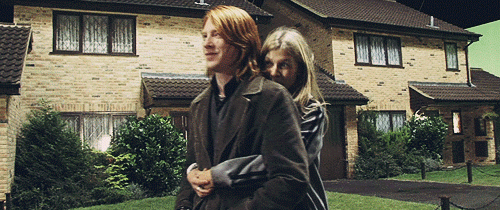
...given the topic, probably best to have a gif of adult characters. Also it’s cute.
There was discussion of what counts as bestiality in a world where all sorts of beings are sentient. I even posited the question that if someone kept up with polyjuice for nine months, could someone usually lacking a uterus become pregnant and give birth? This was laughed down and dismissed as it was meant to. Think it was kinda obvious in how I delivered it that I was being absurd. There was a lot of speculation of what portraits get up to and.... yeah. it was exactly as it sounds.
A lot of fun, and probably nothing teens haven’t heard or thought before but still, a good thing they weren’t there.
I’d have liked to go to bar and play Slash but alas, I was tired so I went to bed. Hoping for sleep and rather sad that the next day would be my last for another year.
[SUNDAY HERE]
5 notes
·
View notes
Text
The Ultimate Guide to Communication Skills
By Dan Silverman

Communication Skills are the abilities to convey information to others effectively and efficiently. These skills are verbal, non-verbal (body language) and written.
What is Communication?
Communication is the act of conveying meanings from one person or group to another. This happens through the use of understood signs, symbols, and semiotic rules. It applies to anyone, including those who don’t speak. Even babies communicate. It is always occurring. People take for granted that Communication Skills don’t just happen. Communication is viewed uniquely by each person based on experiences or understanding of the topic. The other person may hold a different impression of what you mean. This refers to a mental filter.
Mental Filters
An example of a mental filter is what the receiver thinks about the sender. If the person receiving the message doesn’t trust the sender then there is a problem. For instance, we can perceive an honest and sincere message from the sender as bossy.
Avoid unintended communications by using a framework for messages. A profound and exciting story can grab your audience, or your audience can grab their phones and check the game highlights. The difference is all in the delivery.
To learn more about communication, watch our 1-minute video below:
youtube
'The major mistake in communication is to believe that it happens.' - George Shaw
The 5 Elements of the Communication Process
Sender - Receiver - Message - Context - Listening

The process of communication happens on a loop. It starts with the sender as the first element. Feedback and listening as the fifth element and then circling back to the sender.
1. Sender
The person starting the conversation (the sender) knows in their mind what they intend the message to be. By knowing the audience, the person can deliver the message in a format the receiver will know best. Then evaluate the other four elements before you deliver the message. The sender can give the message through text, email, verbal or non-verbal. Regardless of the channel, you still need to follow a framework for the message. This is important so that a message meant to be helpful doesn’t seem indecisive or the opposite, short or rude.
When deciding how to phrase the wording of the message, use the popular and effective Think-Feel-Do (TFD method).
Think. Example: I want the person to think the project is approved.
Feel. Example: The employee should feel valued and appreciated.
Do. Example: I want the person to collaborate with the team.
2. Receiver
The receiver of a message can be one person or a group. They should pay careful attention to the message. Listen and watch the sender’s body language. The receiver should give non-verbal signals to the sender, like nodding in agreement, and smiling if it applies.
3. Message
The message is made from the channel (text, phone, email) and non-verbal communication. The TFD method also plays a part in the message.
4. Context/Channel
The context or channel involves the location, method, timing, and relationship.
You should consider the following:
The confidential nature or emotion of the information. Do you need a quiet office, a large conference room, a newsletter, a television ad, etc?
Is your information complex and involved or easy to communicate?
What channel do you think the receiver will most prefer and understand?
How much time is available?
How will you answer questions if needed?
5. Listen and Give Feedback
Listening and giving feedback is important whether it is verbal or non-verbal. Open-ended questions can gauge your receiver’s understanding of the information. However, errors can occur with feedback, such as:
Closed-ended questions, for instance, 'Is that clear?' Or, 'Do you understand' are used. It may be understood, but the receiver has a different perspective than the sender.
Not listening or watching for any verbal or non-verbal clues of defensiveness, lack of interest or dishonesty.
What Are the 4 Types of Communication Skills?
Do you ever think about HOW you interact with others and what effect it has? Each type of communication is used in different circumstances and to convey a different intent. The basic communication types are intended to persuade, inform, or educate.
The following are the 4 types of communication:
Visual
Written
Verbal
Non-Verbal
1. Visual Communication Skills
Reading or seeing is visual communication. It can be anything that shows a message, expresses an idea and gives information. For example, signs, gestures, postures, or other avenues that can be expressive. An example is the female or male looking stick figures on the door of many public toilets. These are basic symbols that we identify as signalling that this is a women’s or a men's toilet. Another example is a thumb’s up gesture. This shows that things are okay.
2. Written Communication Skills
This is often your first impression to another. It shows your ideas through written symbols. It is the most common form of business communication and includes letters, emails, or text messages to name a few. What is your writing saying about you? What story are you telling?

Important: Whenever you send a written document, still follow the 5 elements as noted above.
Business Writing Done Properly:
Improving your written Communication Skills will improve how others perceive you. Always write without banter and 'fluff' but still keep it warm to develop rapport. Moreover, business writing should remove any information that does not add to the meaning. It should state the aim directly.
There are an estimated 246 billion emails worldwide sent and received daily. On average a manager or executive receives 200 emails per day. Every email you send is a chance to showcase your writing. People judge others based on their tone. The words you use send a message and you don’t want that message to incompetent or rude. Learn how to persuade, inform or educate your audience through writing. This shows confidence, knowledge and success!

3. Verbal Communication Skills
Verbal communication is the process of presenting ideas through speech. This is a particularly important skill for people in sales, customer service and business roles. Positions working with customers and the public require excellent verbal Communication Skills.
The 4 Types of Verbal Communication:
Interpersonal - This is the conversation we have with ourselves. We can choose to keep these conversations to ourselves, for instance, our thoughts. Or we can choose to tell our internal conversation to others.
Interpersonal - This takes place between two people where each person switches roles between sender and receiver.
Small-Group - Two or more people are involved. The number of people involved is kept small, so each one is able to give input. Group meetings, press conferences and board meetings are examples of this.
Public Communication - One person addresses a large group. One sender to many receivers.
4. Non-Verbal Communication Skills
Most people guess what non-verbal is, however, they might miss half the story. Non-verbal is as much about listening and observing as showing your non-verbal cues. In short, non-verbal communication tells the deeper story. An example of non-verbal communication is your response to an employee calling in sick on stock take day. This is the third year in a row it has happened. The night before you saw them at a football game with no visible sickness. You might say 'okay, I hope you feel better' but the tone of your voice conveys irritation and disbelief.
The 4 Types of Non-Verbal Communication:
Eye Contact - This is one of the most valued traits. Someone who looks you in the eye shows they are listening and interested. Not looking someone in the eye can seem dishonest, distracted or disinterested.
Body Language - Body language is strongly tied to psychology. It can convey happiness, disapproval, anger, and the list goes on. Some people show body language that does not match their feelings. Thus, it is important to confirm your impression. This may also make the other person defensive or embarrassed. Remember to read your audience and adjust.
Paralinguistic - A big word referring to inflexion, tone, loudness, pitch and rhythm of your voice. It can express seriousness, boredom, sarcasm, just to name a few.
Facial Expression - Anything on our face that conveys a response to what we hear or say. Lifted eyebrows, pursed lips, smirking are examples, and eye contact.
'60 % of all human communication is nonverbal body language; 30 % is your tone, so that means 90 % of what you are saying doesn’t come from your mouth.' - Alex Hitchens
Excuse the Interruption, but Here’s a Little Bit About Us...
We are the soft skills training provider to the UK Grocery Industry, helping Suppliers to win more business. They choose us because of our money-back guarantee, our relevant experience, and because we make their learning stick.

https://www.makingbusinessmatter.co.uk/about/sticky-learning-method/
Our unique training method, Sticky Learning ®, ensures that your Learners are still using their new skill 5 months later and this is supported by a money-back guarantee.
10 Barriers to Effective Communication
Communication can be slowed or stopped due to barriers. Some are:
Language barriers - Different language or accent.
Linguistic ability - Jargon or buzzwords.
Physical barriers - Actual distance between sender and receiver.
Attitudinal barriers - Personality conflicts, poor management, and resistance to change.
Psychological - behavioural and mental aspects, including anger and stress.
Ambiguity - words that sound the same with different meanings.
Physiological - discomfort, ill health, poor eyesight or hearing.
Technology - multitasking and condensation of information.
Fear of being criticised - Not wanting embarrassment or criticism.
Gender barrier - specific traits of conflict resolution and communication based on gender.
The Impact of Poor Communication
The cost of poor interaction can have a big impact. We often take small misunderstandings in stride and chalk them up to an error. When this happens, take time to reflect. Why did the disconnect happen to begin with? Furthermore, did you contribute to the problem? Often, it is not until large or complex problems come up do we stop to find the cause. Yet, the same primary faults create small problems as large ones.
When Workplace Communication Doesn’t Work
The time and cost involved in daily interactions of workers are hard to measure. Areas that are not productive are addressed and resolved.

This mishap could increase the original cost of the interaction. Companies can help by investing in Communication Skills training course for their employees.
Employees cannot practice skills that they are not trained in. Even so, employees are held responsible for the problems. Finally, employers are starting to estimate more closely the loss of wages to the company. Therefore, companies are including Communication Skills courses in their training budget.
'Speak when you are angry, and you will make the best speech you will ever regret.' - Ambrose Bierce
Communication Skills in the 21st Century Workplace
The skills you need today are evolving at a rapid pace. They need to in order to keep up with the rapidly changing business world. Companies create products in record time, make quick decisions involve many people. In-person discussion is becoming less and less common. In part because of the physical location of coworkers in a global market varies. Your job requires you to interact and collaborate with many types of people. Because Communication Skills are lacking in organisations, we need basic ways to work with one another.
Employers are moving away from slower methods of communications such as desk phones. This is in favour of artificial intelligence-based products such as apps, chatbots and voice assistants. The drive for productivity is leading the effort. There are countless technologies coming out at lightning speed. Yet, humans will need to still interact with clarity, despite barriers.
Problems That Arise From 21st Century Communication
Global businesses give access to millions more people than would be possible of a local company. This requires adjustments that companies do not train their employees in. The lack of skills today can cause lost contracts, employee turnover, and frustrated customers. If your organisation is not global, it still impacts you because of global suppliers and customers. Training will help remain successful when interacting with others.
Examples of modern communication barriers:
Physical Location
Difficulties can happen when working with others in another time-zone. An example would be a coworker in the United Kingdom. They are working with someone in the United States. There is a five hour time difference. The start of business in the U.K. maybe 4:00 am in the U.S.
There is an increase in email usage even to give complex messages. We know complex topics are better discussed in person or by phone. This can lead to misunderstandings and delays. Everyday information is okay. When decisions are needed or participation is required, it is inconvenient. Not to mention it impacts the relationship of coworkers.

Talk over what working hours will work to contact the other person. The person in the U.S. may not mind being contacted at 6:00 am. However, to be nice, the U.K. does not contact the U.S. worker until the U.S. office hours. Remote worker situations can be a challenge. Furthermore, employees may not even be in a different time zone but located off-site. Yet, this can still isolate the employee and complicate communication.
Generational Differences
Employees are working longer. Much longer. Recent studies suggest that workers aged 55 and older currently make up 16% of the total workforce in the European Union. For comparison, for every 10 Generation Z employees, there are 12 people aged 65 or older in the EU.
Workers are staying in jobs longer for many reasons, for example:
Lack of financial savings.
Longer, healthier living means a person can still work.
Workers stay due to talent shortages to fill their role.
Some people enjoy their job and want to remain productive.
Regardless of the reason, working with multiple generations in the workforce requires consideration. Keep in mind that many ideas about older workers can often be stereotypes. These include slow pace, resistance to training and new ideas.
Understand that stereotypes may not be true.
An example is older workers and technology:
Older workers rarely have technology skills that younger workers do. The communication style present today is not what the older generation was raised with. This changes with each generation. An example of this would be a direct message (DM) or instant message (IM). Many older workers prefer to contact by phone or email and may not be familiar with a DM or IM. They also may not see the benefit in it. Younger workers use it more often and the familiar tool is second nature as they have grown up with it. To a younger or middle-aged person, this is an effective and quick way to ask a question or inform. It is fast and doesn’t require a full-blown email or phone call.

Cultural Differences
An obvious difference between employees being from different countries is language. We can misinterpret the intended meaning and cause offence and feelings of resentment. A frequent issue is using Google translate or something similar to translate a message. The semantics of the message are different from intended. Even if the other person gets the concept, more explanation is needed. Whether by personality or culture, some people are direct and to the point. This can be taken as cold and rude.
Advanced Technology
The virtual world and the global workplace are similar. In both places, a process of communication should be followed. This requires observing the other person. With technology, you may use the latest and greatest tools. However, if a coworker in an impoverished country cannot access these tools, then you need to make accommodations. Just as in person. If a person has a barrier to communication, then you need to adjust your style.
An example of this would make certain that everyone involved has access to the same technology. For instance, if five people use a team app such as Slack, however, two others can only use email. You need, therefore, to provide a summary of all discussions through Slack. Forwarded to the two individuals via email and request their feedback. Lastly, if this occurs, try to make efforts to find a programme that works for everyone.
Why Is It Important to Listen?
To listen is to learn. Hearing is different from listening. You don’t become a better listener simply by hearing more. Listening is intentional and focused. There are many aspects to listening. When you practice focused listening, you start to realise those details. It is a skill. Your practice can be with strangers, friends, or coworkers.

Listening happens as much with your eyes as with your ears. Eye-rolling for annoyance, or head nodding in agreement. Non-verbally we can observe with our eyes. Exclamation marks or words written in all caps can signal anger or excitement. Any uncertain actions mean the sender needs to clarify the message. It is up to the sender to craft a message that the receiver is able to understand with clarity. Oversight because of the wrong context or channel should not be blamed on the receiver.
Questioning
To help determine if a message was clear or to get further information, you can use questioning.
Open-ended questions. These require a longer answer with some detail.
Closed-end questions. Questions that answered with one-word answers. Yes, no, maybe. They stop the conversation.
Funnelling. Start with general questions and then ask questions that drill down on that topic. Each question is more direct and decisive. This is a common tactic with police.
Focused Listening
There are 6 Key Qualities of Focused Listening:
Smile genuinely. This builds warmth and rapport.
Appear alert by standing or sitting with good posture and look attentive.
Show your focus. Control distractions and fidgeting.
Find a commonality. Either personal or professional.
Keep it positive. Don’t complain or say negative things about others.
Ask open-ended questions. This keeps the conversation ball rolling.
'Listen with curiosity. Speak with honesty. Act with integrity. The greatest problem with communication is we don’t listen to understand. We listen to reply. When we listen with curiosity, we don’t listen with the intent to reply. We listen for what’s behind the words.' - Roy T. Bennett
5 Basic Styles of Communication Skills
When you know your style of communication, then you can interact confidently when encountering the individual styles below:
Assertive
Aggressive
Passive-aggressive
Submissive
Manipulative
The Five Basic Styles of Communication each using corresponding verbal and non-verbal characteristics. Each style has common words and phrases.
1. Assertive
Is mentally and emotionally the healthiest of the styles; however, the fewest people use this style of communication. They advocate for themselves and state their needs. They address issues as they arise.
2. Aggressive
People express their emotions and opinions with a domineering attitude that can often be harmful to others.
3. Passive Aggressive
Individuals seem calm and passive but bring down others in subtle ways. This is often because they cannot directly deal with their anger or resentment.
4. Submissive
Is about pleasing other people. They believe other’s needs are more important than their own. They think others can contribute more than they can.
5. Manipulative
A type of person with their best interest in mind. They are cunning and good at influencing and controlling others. They ask indirectly for their needs to be met, making others feel sorry for them.

'Don’t use words too big for the subject. Don’t say infinitely when you mean very; otherwise, you’ll have no word left when you want to talk about something really infinite.' - C.S. Lewis
How to Deal with Communication Problems
The best way to communicate with others is not a guessing game. Follow the details below and you will have smooth interactions going forward. Communication problems will be helped if you understand where the process stopped working. Find where the misunderstanding occurred, and you resolve the issue quicker. Whether you can determine the point of communication problem or not, you need to open the communication channel. You can start this by the following.
Show Empathy and Listen with Intent
To establish dialogue can be scary and uncertain for both parties. Make the person comfortable and create a secure environment to share information. First, let them know you understand their message by practising methods of effective communication. Show you are a trusted individual by focused listening and using the best method for them. Lastly, let them know you would like to help solve the issue. This is done through verbal and non-verbal communication.
Questioning
Use the questioning method of communication to ask good, relevant questions. Then evaluate additional details. Match the tone and pace of the other person so it does not appear that you are rapid-firing questions. Give the person enough space and time to convey information.
Provide Guidance
It is likely the person has come to you for help in solving the problem. Part of a leader’s role is working together to figure out the next best steps. Further investigation is often the next step. Brainstorm ideas together and detail what should happen next. Get answers from others if needed. Make it clear you would like to improve or solve the problem. The issue is important to them and to you.
Follow Up
Be certain the person knows when they will hear from you. Recap the overview of the conversation. The recap should be written and documented so they can correct any errors. Letter or email is appropriate to use. Anything wrong in the wording or meaning should be corrected and a new recap sent. Regardless if you are a manager, human resources, or an employee; set the tone and follow the process. It will reduce future communication problems and furthermore, headaches.
Watch our interview with Lee McDonald of the Said Business School Oxford, discussing how better communication can help improve office politics:
youtube
Can Better Communication Skills Help Me Get Ahead?
As mentioned, Communication Skills are a hot commodity. Human resource departments are actively seeking out high-end soft skills. These skills show you are flexible and can be trained for future positions.
State your level of skills on your CV. Then during a phone interview, you can describe examples of how you have used the skills. When you get the in-person interview, show concrete examples. Use body language that portrays self-confidence.
For Example:
Sales would need articulation, negotiation skills, persuasion, wit, clarity in speaking, presentation skills.
Customer service would need conflict management, interpersonal skills, empathy, warmth, negotiation.
Human Resources would need listening, interpersonal, social, conflict management and people management skills.
Purchasing would need accuracy, negotiation, conflict management.
Take a cue from the job description. Include areas from the company’s core values to tie into the culture.
Try searching on a job board for your best communication trait. Such as negotiation. You might be interested in the results. A wide range of opportunities and industries could be open to you. Your cover letter should lead with your solution to their problem. What problem can you fix that is a key component of the job?
Communication Competency
This improves the skills and relationships you bring to a company. Companies now create assessments around this competency before hiring. Will you make the cut?
The Job Interview
The Importance of Networking
Low rates of unemployment. The high number of applicants for each job. This scenario makes networking imperative. It can help get your foot in the door for the interview.
Use a framework of pitching to create a successful request. Remember, you never know if you never ask.
Advice from LinkedIn Learning encourages us to Use the What - Why - How - format.
Be direct when you ask.
What. State the action you need directly.
Why. Create urgency.
How. Make the next steps for the decision-maker as easy as possible.
Let’s try an example:
You sent out countless CVs but did not get a call. A position has opened up where an old acquaintance works but you are reluctant to reach out. It is uncomfortable to ask a favour from this person even though you had a good history.
What action do you need? An opportunity with your organisation has opened up and I would like to get your insight on the position.
Why is this time-sensitive? My current company has shut its doors. As the only income in my house, I am actively looking for a new position.
How are the next steps easy for me to take? Would you be willing to tell me about what your company values in an employee? Can I put your name down as a reference? I am finished with the application aside from references.
This scenario should give a successful ask.
Take your questioning a step further with 5 Bums on a Rugby Post:

As you can see from the image we've extended it a bit further. Firstly, the rugby post forms an ‘H’. This is for ‘How’. Each of the bums is a ‘W’. These remind us of five open questions, ‘Who’, ‘What’, ‘When’, ‘Where’, ‘Why’. You should think about your pitch and ask these questions. This is an easy way to remember all the questions you need to answer to be prepared for any eventuality.
Communication Skills in An Interview:
An interview can be daunting. Use the five elements of the communication process and you are certain to look prepared!
Sender - You deliver solid, quantified examples.
Receiver - The interviewer uses proper communication methods to listen and understand your message.
Message - Through body language you portray self-confidence. Through the clarity of speech, you show capability. You have a logical order for your presentation. Your ideas are easy to understand.
Context - You present through the visual slideshow and physical products you have designed.
Feedback - You ask questions to make sure they understand your capabilities and interests. You receive their feedback. You get a callback!
Show Off Your Skills on A CV
The old ways of adding keywords to your CV would be enough to get a phone call. Now you need to go much further to get your name and CV in front of a decision-maker.
Applicant tracking systems are designed to find the best candidate, on paper. Your desirable traits can only be found by self-promotion. One area of self-promotion is to include keywords on your CV that match the primary job description or functions.
Match your skills to where the industry is going. Understand trends in the industry and keep up with major news in the field.
Conduct A Meeting
Meetings are a hot spot for communication difficulties. People from different countries or remote workers may chime in. The meeting could contain several departments and functions. Each department, such as accounting, human resources, and sales having different perspectives.
It is helpful in a meeting with a lot of information and various knowledge bases to have a facilitator. This person will direct the verbal traffic of the meeting.
The facilitator pays attention to comments, questions, and non-verbal cues. Paraphrase or recap the comment helps to know if the intent is understood. It also engages conversation.
Recap of non-verbal cues can sound something like:
'Mike, it looks like you have concerns' or 'Jill, did you want to add something?'. This gives someone an open invitation to discuss. You are also receiving verbal affirmation of the other person’s views.
Reuse the same verbiage or subtle gestures as the person or group you are communicating with. Match the other person’s words, tone or gestures to give a sense of commonality. When someone identifies with another, they can share their ideas without fear.
How to Improve Your Communication Skills
The easiest way to develop your Communication Skills is to attend a training session to help you to get your message across more succinctly and effectively. Formal training will help you understand the theoretical models in the classroom. Moreover, it will give you the chance to practice in a safe and comfortable space. We suggest taking our Communication Training Course, or a shorter course to refine your skills for a specific situation, for instance, meetings. It is then critical that you embed the skills by using them in your day to day role.

If you prefer a more personal and bespoke touch, we suggest you consider getting someone to coach you. This could be an external professional or someone you trust in the business to push you. The main purpose of executive coaching is to help you think about your behaviours and skills differently. Moreover, to make sure that you are being held accountable for using the skills you have. You only become better by pushing yourself to use new models and challenge your existing behaviours.
For more information, please contact us or fill out the form at the end of this article. Our trainers are from your industry and can provide training on any one of our products, from Myers Briggs and GSCOP to Category Management, and HBDI. Furthermore, we use our unique Sticky Learning method which is guaranteed to make your learning stick.
Communication Skills - In Summary
They improve relationships, seal deals, and help you to negotiate a pay rise. The importance of Communication Skills in life cannot be overstated. They are vital to success in every relationship. Communication is the product of the future. Improving your Communication Skills through training is a great way to see real results in your personal and professional life.
'Assumptions are the termites of relationships.' - Henry Winkler
Further Reading and Resources
You can find further insight, detailed definitions and clarification of all the key Communication Skills terms mentioned in this guide in our Glossary of Terms.
Communication Skills Quotes
'We have two ears and one mouth so we can listen twice as much as we speak'. – Epictetus
'Research indicates that employees have three prime needs: Interesting work, recognition for doing a good job, and being let in on things that are going on in the company.' Zig Ziglar
'Know when to email vs. when to meet. Logistics are best handled over a non-immediate communication channel like email or Asana tasks. Detailed status meetings will suck the life out of your day.' - Justin Rosenstein
'Feedback is the breakfast of champions.' - Ken Blanchard
Communication Skills Videos
Watch our Communication Skills playlist from our YouTube channel:
youtube
Take a look at Celeste Headlee discussing ways to have better conversations in her TED Talk:
youtube
Watch Lera Boroditsky exploring how language shapes how we think and communicate:
youtube
Contact Us
Feel free to get in touch to find out how our Communication Course can help you improve your Communication Skills. Simply fill out the form below, and we will be happy to get back to you with further information:
About Dan Silverman
Dan is an experienced career development professional and leadership coach. His strengths lie in defining goals and assessing capabilities to implement strategic business plans and build key relationships. He has a solid background in developing HR strategic plans, policies, and creating programmes designed to attract and retain highly motivated and productive employees.
0 notes
Photo

RIVAL SUMERIAN CITY STATES OF UMMA AND LAGASH
This is an excerpt from my post: THE SUMERIANS, FOREFATHERS OF CIVILIZATION IN MESOPOTAMIA.
Mesalim, King of Kish (Lugal Kishi)
“Enlil, king of all the lands, father of all the gods, by his righteous command, for Ningirsu and Shara, demarcated the (border) ground. Mesalim, king of Kish, by the command of Ishtaran, laid the measuring line upon it, and on that place he erected a stele.”
The two Sumerian cities of Umma and Lagash, like Mycenae and Troy or Athens and Sparta, were rivals for much of their existence. Border disputes were common and to settle them Mesalim, king of Kish, stepped in and attempted to end these conflicts. Umma and Lagash were more than 20 miles apart and at their center was the Guedena, a fertile field and irrigated canal that is fed by the Tigris and Euphrates Rivers; Lagash dedicated this area to their patron god Ningirsu (“lord of Girsu”; god of war, hunting, plowing, fertility, rain and irrigation). Mesalim set down a boundary stele between both cities but since Lagash also owned the city of Girsu that was located south of the Guedena they ultimately held more land than Umma. It seems like Ush, ensi of Umma, disagreed with the division of land since he removed the stele and these two armies clashed.
“Ush, ruler of Umma, something greatly beyond words he did. That stele he tore out, and into the plain of Lagash he entered.”

^ Umma in Blue, Lagash in Purple and Girsu in Green.
Umma had lost to Lagash who “cast (his) big battle-net upon it, and its many tumuli he laid upon the ground in the plain”. Lugal-sha-engur, king of Lagash, was said to have been given, by Mesalim the King of Kish, a ceremonial mace-head to place in the Temple of Ningursu in Lagash.

^ The inscription on the mace reads: “Mesilim, king of Kish, builder of the temple of Ningirsu, brought [this mace head] for Ningirsu, Lugalshaengur [being] prince of Lagash.”
This mace-head shows the design of a lion-headed eagle, symbol of Ningirsu the patron god of Lagash and Girsu. These conflicts started before this battle and would continue until long after, Umma would usually find themselves on the losing end. After battle the enemy dead would be piled up and these hills of bodies would then be covered in dirt, some of these tumuli (burial mounds) were built so high that ladders would sometimes be needed to cover them completely.
EANNATUM, ENSI OF LAGASH
‘Everybody wants to rule the world’

^ “Eannatum, ensi [of] Lagash”.
It seems as though Eannatum’s future as a warrior-king was set since birth, his name was inspired by the name of Inanna’s (goddess of war) temple, E-anna. Ultimately his name meant “Befitting the E-anna”. He also claimed that his ‘divine father’ was Ningirsu, the god of war (patron deity of Lagash).
Victory over Umma
“The ruler of Umma, where has he (ever) been appeased? With … men … he has been able to exploit the Gu'edena, the beloved field of Ningirsu. Let him be cast down!”
It is inscribed that Eannatum was visited by Ningirsu (God of War) in a dream and told him to make war on Umma.

^ The Sumerians at war by HongNian Zhang.
“Umma, like Kish, shall therefore wander about, and by means of ones seized by anger shall surely be removed. On your right side, Utu [the sun god] I shall let come forth upon you. and a … I shall let be bound upon your forehead” “him [Umma] I shall smite, and their myriad corpses I shall make stretch to the horizon.”
“They fought each other, and towards Eannatum a man shot an arrow. He was penetrated by the arrow, but he broke it off. In front of them he made screams”
“Eannatum, in Umma, like a destructive storm of rain, he left behind a deluge.”
“Umma he defeated, and twenty tumuli (burial mounds) for it he heaped up there. Eannatum, wept over with sweet tears (of joy)…”
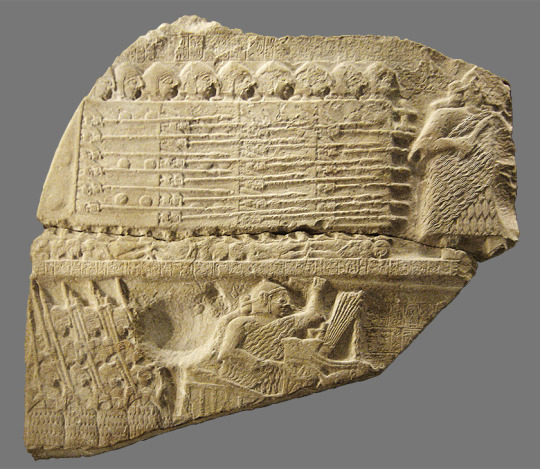
^ Vulture Stele commemorating Eannatum of Lagash’s victory over Umma.
Eannatum set a boundary stone and had Enkale (now king of Umma) swear an oath on “the great casting-net of Enlil” to pay tribute to Lagash in exchange for them maintaining the Guedena and using a portion of it. Now with their rival subdued, they were now free to redirect their military.
“By the life of Enlil, king of heaven and earth, the fields of Ningirsu I shall exploit as an interest-bearing loan. I shall operate the levees up to the spring, and forever and ever over the boundary territory of Ningirsu I shall not cross. To its levees and irrigation ditches I shall not make changes. Its steles I shall not smash to bits. On a day when I may cross over it, the great casting-net of Enlil, king of heaven and earth, by which I have sworn, upon Umma may it fall from the sky!”
Victory over Elam
To the east was a land named Elam, ethnically and linguistically different then their neighbors in Mesopotamia; the Zagros mountains marked the edge of the known world to the Sumerians and Akkadians. The rivers Karun and Karkheh sprouted out from the Zagros Mountains, feeding the landscape of the Elamites. A rich competitor that had historically made incursions into Mesopotamia and even ruled over it under the Awan Dynasty of Elam, it was an importer mostly of food and exporter of timber, horses (from the Iranian Plateau), cattle, wool, lapis lazuli, slaves, silver, gold and most importantly tin (from the Zagros mountains).

This being the Bronze Age, the use of copper weapons lessened in favor of the more durable, harder bronze which can be made from smelting copper and tin. He destroyed their capital city of Susa as well as other cities and forced them into paying him tribute.

He also took over a city state named Uru(a) which sat within the Susiana plain, a commercially significant city that not only held sway over certain passages, trade routes and choke-points but was also used by other cities for their skill in using tin to turn copper into bronze, therefore strengthening military arms and armors.
“By Eannatum, Elam, the awesome mountain range, was defeated, and its tumuli {burial mounds} he heaped up.”
“Elam and Subartu, the lands of timber and goods, he defeated.” “Susa he defeated. The Standard of Uru(a), though by its ruler, it had been set up at the head (of it), he defeated it.” – Vulture Stele.
Elam was once like Sumer and Akkad, dotted with many city-states (most notably Susa and Anshan) but under threat from their hostile western neighbors they allied to form a unified state.
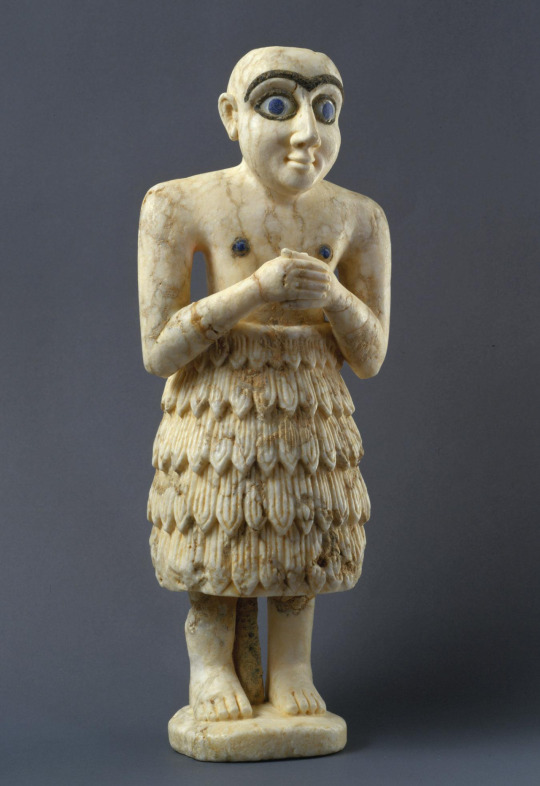
^ Votive Statue of Eannatum made of Alabaster, lapis lazuli, mother of pearl inlays, and modern bitumen inlays.
King of Kings
Now in a better financial position and militarily secure on his western and eastern flanks, he could, If he wished, continue expanding his reach. He defeated and subjugated two important Sumerian city states that lay beside the Euphrates River named Uruk and Ur.
“Uruk he defeated. Ur he defeated. Kiutu he defeated. Iriaz he destroyed, and its ruler he killed. Mishime he destroyed. Arua he obliterated. Before Eannatum, the one nominated by Ningirsu, all the lands trembled.”

^ Eannatum by Leugi, from a Civilization V mod that adds the Sumerians.
Zuzu the king of Akshak (In Sumer, near Akkadian Kish) advanced against him and once again Eannatum had proven victorious.
“In the year that the king of Akshak rose up, Eannatum, the one nominated by Ningirsu, from the Antasura of Ningirsu Zuzu, the king of Akshak, all the way back to Akshak he smote, and he obliterated it – Zuzu, along with his forces, faced Eannatum and his army and a battle commenced. Eventually, Zuzu was killed in combat and his city-state of Akshak taken”
Defeating both Kish and Mari he became the new King of Kish, still having to deal with rebelling coalitions of enemies (most involving Elam, Kish and Akshak), who he too drove back, all the while never losing a battle in his entire military career. Eannatum should not only be remembered as a skilled commander, but also for instituting the building of numerous temples, canals and cities. This is thought by some to be the world’s first empire; Eannatum conquered much of the known world and set a president for future conquerors that would reach and exceed his accomplishments. Soon after Eannatum’s death Lagash quickly crumbled as their former enemies scrambled to pick the bones off of his dying empire.
LUGALANDA, ENSI OF LAGASH
‘Face to face with the man who sold the world’
Lugalanda, ensi of Lagash, was infamous for his viciously corrupt leadership; taking ownership of the temples of Ningirsu (god of war), Bau (goddess of healing) and Shulshagana (son of Ningirsu and Bau) while placing his men (“men of the ensi [Lugalanda]”), his wife and himself in control of them. As long as they shared in their riches, all forms of government and administration freely exploited and abused their power. They began taxing the priesthood while confiscating the possessions of others (lands, livestock, fish and boats). People were forced into manual labor, temples began using sacred temple oxen to plow the fields, they charged an excessive amount for the burying of the dead, religious ceremonies and sacred rites.
In the “Liberty Cones” we read that Urukagina (also known as Uruinimgina), with the support of the common people (fishermen, shepherds, priests, farmers, etc.) seized the throne without bloodshed. He cleaned house; removing corruption and returning confiscated lands and property, set limits on temple fees, provided charity to the elderly and the poor and by amnesty “their prison he cleared out”. Seen as the earliest evidence of civil and legal reforms in history (2300′s BCE), they would not be outdone until the Code of Hammurabi (1700′s BCE).

^ Urukagina Liberty Cones.
As you will see, the pious king Urukagina of Lagash would soon become the target of Umma’s long held frustrations.
Urukagina: “For my part, what did I have of it?”. I said to him: “I did not do any violent act, but the dogs (the enemy under Lugalzagesi) today are …[damaged text] … my city”
LUGALZAGESI, ENSI OF UMMA
‘times are gone for honest men, and sometimes far too long for snakes’

After the death of Eannatum the Great hostilities had once again commenced between Lagash and Umma. Under the Uruk rulers Lugalkinishedudu and Enshakushana, there was a revival in Uruk dominance. Uruk and Ur were linked, Kish and Anshak were taken and the rulers of Uruk retained the title ‘King of Kish’. During the reign of Eannatum the Great’s nephew, Enanatum II, Lagash had declined in power and reputation; most that were once under the heel of Lagash had since rebelled and Umma began growing under the leadership of the “Man of Umma”, Lugalzagesi.
Lugalzagesi, great-grandson of Il (who took the Guedena from Lagash), was a high-priest of Nisaba (patron deity of Umma; goddess of wisdom, writing, scribes and harvest) and ensi of Umma who had also retained control over Uruk (some think through marriage, others by conquest or diplomacy) and its subject city-states. Moving his capital from Umma to Uruk, he began to be referred to as the ‘king of Uruk’, all that was left was for Lugalzagesi to take Lagash and Girsu.
After many failed attempts to defeat Urukagina of Lagash, Lugalzagesi of Umma had finally proven victorious The city was viciously sacked and destroyed as “The Man of Umma” plundered palaces, temples, daises and sacred groves; carrying off their “precious metals and lapis-lazuli”. Setting these holy places on fire and even demolishing and tipping over statues. The Sumerians were a strongly religious people and although they were not new to warfare, such sacrilegious acts against holy structures greatly offended them. A priest-scribe writes:
“The leader of Umma, having sacked Lagash, has committed a sin against Ningirsu (patron war god of Lagash). The hand which he has raised against him (Ningirsu) will be cut off!” “May Nisaba (patron deity of Umma), the god of Lugalzagesi, ruler of Umma, makes him bear the sin!”

^ Umma attacks Lagash.
Now having subjugated all of Sumer he would then aim his focus northward and conquer the lands of Akkad.
“king of all the lands, to Lugalzagesi the kingship of the nation had given, and the eyes of the nation he had let be directed toward him, and all the lands at his feet he had placed, and from east to west he had made them subject to him, from the Lower Sea [Persian Gulf], along the Tigris and Euphrates [rivers] to the Upper [Mediterranean] Sea”.
While Eannatum the Great had also conquered many of these lands, according to the texts it was Lugalzagesi’s empire that was truly united and happy during his reign. However this is usually seen as propaganda spread by Lugalzagesi, and the far reaching extent of his conquests are often questioned.
“In those days, Uruk in rejoicing spent its days under him. Ur, like a bull, its head skyward did lift up under him.”
“All the lands in river meadows rested (contentedly) under him, and the nation was happily making merry under him.”
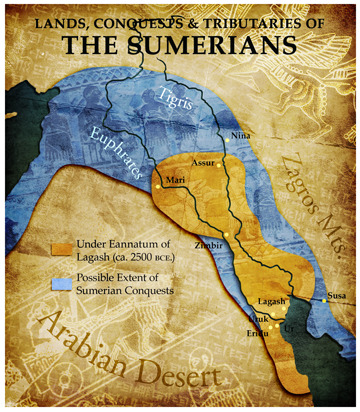
^ Civilization V mod that adds the Sumerians .
Soon another force would rise which would exceed the successes of both Eannatum and Lugalzagesi, one who would conquer and unite much of the known world, Sargon the Great of Akkad.
If there are any errors please privately inbox me so I can update it. As always, if you’d like to read or learn about any specific historical subjects just let me know what they are and I will take note of them.
See Also:
For information on one of the earliest recorded civilizations on earth, the Mesopotamian flood myth, the evolution into city-states and their rivalrous history - read: THE SUMERIANS, FOREFATHERS OF CIVILIZATION IN MESOPOTAMIA.
For information on Sargon the Great and his Akkadian Empire, the revival of the Sumerian Empire, the Gutian and Amorite invasions as well as the Sumer-Akkadian military - read: THE AKKADIANS AND THE SUMERIAN RENAISSANCE, BRONZE AGE TITANS OF MESOPOTAMIA.
125 notes
·
View notes
Text
Transcript Episode 26: Why do C and G come in hard and soft versions? Palatalization
This is a transcript for Lingthusiasm Episode 26: Why do C and G come in hard and soft versions? Palatalization. It’s been lightly edited for readability. Listen to the episode here or wherever you get your podcasts. Links to studies mentioned and further reading can be found on the Episode 26 show notes page.
[Music]
Gretchen: Welcome to Lingthusiasm, a podcast that's enthusiastic about linguistics! I'm Gretchen McCulloch.
Lauren: And I'm Lauren Gawne, and today, we're getting enthusiastic about palatalisation. That is to say, “What the heck is going on with G and C?” But first, thanks to everyone for your enthusiastic recommending during our November Recommend-A-Thon.
Gretchen: Yes, thanks so much for all your tweets, and posts, and shares, and all of the new people that you've brought in with you to listen to Lingthusiasm.
Lauren: We will be thanking every one of you who made some kind of public declaration about their love of Lingthusiasm. We'll give you until the end of the month to add yourself to that esteemed group of people, so we can thank you all in our annual anniversary post.
Gretchen: Yes, so you have till the end of November 2018 to be part of this year's Recommend-A-Thon thank you post, which will live in perpetuity on our website. Last year we thanked 100 people. This year, I think we can thank even more. I'm really excited by what we've seen so far.
Lauren: I'm feeling very confident about that. And of course, you can continue to recommend us to anyone who needs a little more linguistics in their life any time of the year.
Gretchen: I also want to thank everybody who came out to the live shows.
Lauren: Yay! I'm not gonna lie, we're recording this before the live shows.
Gretchen: So we're really hoping people actually come.
Lauren: We are just going to have to assume that they were an absolute rolling success.
Gretchen: We're recording well in advance at the moment to make sure that we have episodes for when Lauren's on leave. We're very excited about those live shows. I assume they were great. Thanks so much to everyone who came out in Melbourne and Sydney. It was so fun to get to see those cities. We also want to remind you that if you're thinking about getting Lingthusiasm merch for any linguists or language enthusiasts in your life, if you want to get someone a scarf with the International Phonetic Alphabet, or tree symbol diagrams on them, or a tie with the IPA on it, or various baby outfits, or T-shirts that say, “Not judging your grammar, just analysing it,” or many other things, now is a great time to place an order so that arrives towards the end of the year.
Lauren: Remember, it's also totally okay to use this as a list of suggestions for other people to buy you, or if you enjoy doing a bit of holiday shopping for yourself, we're not gonna stop you.
Gretchen: We definitely noticed from last year that RedBubble typically runs some sales this time of year, so hopefully, you can take advantage of those to get you and/or your friends and family some great Lingthusiasm swag.
Lauren: Speaking of the holiday season, it's a very important holiday season coming up that's the Northern Hemisphere winter conference season, which I'm usually excited about. Not doing so much travel this year.
Gretchen: Well, the Australian Linguistic Society is also having its annual meeting in Adelaide in December, which I'm going to be at because I'm still in Australia. Our latest Patreon bonus episode is all about the academic conference circuit and how to make it work for you.
Lauren: I had a lot of fun in this episode. This is all of mine and Gretchen's favourite survival tips for navigating academic conferences. If you've never been to one before, or you've only been to a couple, they're lots of fun, and they can be even more fun.
Gretchen: Yes, so you can go to patreon.com/lingthusiasm to check those out, or lingthusiasm.com/merch for the merch. We’ll repeat those links at the end of the episode, so you don't have to write them down now.
[Music]
Gretchen: So, G and C are really weird letters because they're these two letters that, in a whole bunch of languages, often come with multiple sounds. You have the sounds in their names like /dʒ/ and /s/, and then you have other sounds like /g/ and /k/, and then even more sounds. These letters are so weird.
Lauren: I'm not known for being the most reliable when it comes to a spelling bee, and I feel like it's often letters like G and C that trip me up because they have so many different pronunciation disguises that they put on.
Gretchen: They really do. They especially do that in different languages. You can do a brief sample of this through different languages' words for “cheese.”
Lauren: Ooo, let's do a cross-linguistic cheese platter!
Gretchen: Cross-linguistic cheese tour! First, we have the Latin “caseus” (/kaseʊs/) meaning “cheese.” And this gives rise to a whole bunch of other words for “cheese” in different languages. You have English “cheese” (/tʃi:z/), you have German “Käse” (/ke:zə/), you have Spanish “queso” (/keso/).
Lauren: Yeah. Because I was like, “Well, in Italian you have ‘formaggio,’” which is like a completely different historical word. But then I remembered that my favourite Italian pasta from Rome is cacio (/katʃo/) e pepe and that's – the Italian-Latin word for “cheese” is still hidden in that very excellent pasta dish.
Gretchen: And then because I started thinking about this, I was looking up other languages’ word for “cheese,” and I saw the Dutch “kaas” (/kɑːs/), which, I don't speak any Dutch, but there's one Dutch word that I know which is “pindakaas,” and “pindakaas” literally translates as “peanut cheese.”
Lauren: Oh. Oh, hang on. Like peanut butter?
Gretchen: Yeah, so the Dutch word for “peanut butter” is literally translated as “peanut cheese,” which at first seems like, “This is maybe an interesting dish,” but then you're like, “Is ‘peanut butter’ really any better as a term for it?” Because it's still a dairy metaphor.
Lauren: Yeah, because I was like, “That's a weird choice,” but actually, it's not that different.
Gretchen: It's really not that different at all. Especially, if you think of a cream cheese, which is like a creamier cheese, maybe? Peanut butter is kind of creamy sometimes.
Lauren: I'm still gonna eat it no matter what it's called.
Gretchen: Then you have Irish “cáis” (/kɑːʃ/), which is also from Latin “caseus”. “Caseus” is spelled with a C and an S. They're pronounced /k/ and /s/.
Lauren: Yeah.
Gretchen: But “cheese” takes that initial /k/ and makes it /tʃ/. “Käse” and “queso” and “cacio” keep that initial /k/ sound at the beginning, but “cacio” changes the /s/ into /tʃ/.
Lauren: Yeah.
Gretchen: Dutch keeps it the way it was. And then Irish also changes the second one into “cáis” (/kɑːʃ/). Different languages have taken this one word that seemed like it had a fairly straightforward pronunciation and altered it in slightly different ways.
Lauren: I was trying to make a cheese metaphor about things, like, fermenting and going funky with age, but I guess this is why we’re a linguistics podcast and not a food podcast.
Gretchen: “Welcome to Lingthusiasm, a food podcast about linguistics.” And this is all this weird stuff that C gets up to between different languages, historically, and in different languages in the modern era. G does the same type of thing. If you were a kid, you might have learned about hard G and soft G, or hard C and soft C.
Lauren: I really struggle with the idea of hard C and soft C, and hard G and soft G. Just to help other people who might as well, hard G is the /g/ sound and soft G is when it's used more like /ʒ/.
Gretchen: Yes, /ʒ/ or /dʒ/, which is one of the reasons why this terminology is not generally linguist-approved.
Lauren: Yeah, I just – I think about, for example, when I was chatting with Suzy Styles on the work we do about how we have this cross-sensory idea and “hard” and “soft” as a metaphor just don't work for me for those sounds. Apologies if I leave Gretchen to do all of the explaining the difference between them today.
Gretchen: Well, I don't think I'm really going to use the terms either. I'm just gonna mention the specific sound because you see when it happens cross-linguistically, there's a lot more going on than just that. These are two letters that both have that hard-soft thing going on. We don't talk about “hard Q” and “soft Q,” or “hard P” and “soft P.”
Lauren: Yeah.
Gretchen: So why do these letters come in hard and soft versions, even if you can't remember which version is which? To do this, we need to also go back to the Romans.
Lauren: Yes, there were simpler times back in Old Latin.
Gretchen: The Latin alphabet comes from Greek, as a lot of people know. But this is one of things that always puzzled me as a kid – because I was a kid who was into the Greek alphabet – I was like, “Look, the Greeks have this letter, kappa, which stands for the K sound, and it looks like a K, and it's where we get the modern K. And they have this letter, gamma, which was very clearly supposed to be a G. Who invented the C? Why is it there, and why does it cause me so much trouble?”
Lauren: Yeah.
Gretchen: It turns out that this is explained by the Etruscans, who were people that didn't make a distinction between the /g/ sound and the /k/ sound, like the sound in “gamma” and the sound in “kappa.” They borrowed the Greek alphabet for their language, which we don't know very much about, but we know that they didn't care about the difference between gamma and kappa because they just borrowed one, which was gamma, and they used it for both because it didn't really matter for them. Then, the Romans actually didn't initially borrow their alphabet from the Greeks. They borrowed it from the Etruscans.
Lauren: Because the Etruscans were living on the Italian peninsula, so they just borrowed it from the locals.
Gretchen: Yeah, so they just borrowed it from the locals.
Lauren: I do love an ethically locally sourced alphabet, personally.
Gretchen: Nice, locally sourced alphabet. We have fragments of pottery from the Etruscans, but we don't know a whole lot about their language. We know it wasn't Indo-European because all the Indo-European languages do distinguish between the gamma and the kappa sounds. So the Romans borrow it from the Etruscans, and then they're left with like, “Oh, geez, we actually do want to make this distinction between these two sounds that we have, but the Etruscans don't have.”
Lauren: And so someone invented the letter G.
Gretchen: Like an actual person?
Lauren: Apparently. I mean, I'm quoting from Wikipedia.
Gretchen: Do we know their name?
Lauren: Apparently, his name was Spurius Carvilius Ruga, which definitely doesn't sound like a spurious name at all.
Gretchen: That's a really spurious name. So he invented the letter G?
Lauren: Yeah, so at this point the letter C was the third letter in the alphabet, still, and he was like, “Well, look, we have this /k/ sound.” K wasn't cool anymore as a letter to represent /k/. They were all using the rounded – what we think of as C now. He was like, “We need to make more of a distinction.” And so apparently – there are people who disagree with this, but I like this story about young Spurius – created the letter G and was like, “Now, we can make the distinction again.”
Gretchen: If you look at a capital G, it just looks like a C with an extra stroke added on to it, right?
Lauren: Yeah.
Gretchen: A gamma is like a right angle in the top left corner (Γ), and then you can curve it to make a C, and then you can add an extra stroke to make the G.
Lauren: So that's where the Romans got to. And he popped it in the alphabet in the seventh position, which is originally where a little Greek letter known as "zeta" used to live.
Gretchen: So is he responsible for the demotion of zeta as well?
Lauren: Yeah. I mean, well, no, Z also wasn't cool anymore, because the Romans didn't need it, so they never really borrowed it from the Greeks. Because, again, they got all their alphabet from the Etruscans. So the Romans weren't really down with –
Gretchen: Oh, that’s it. Okay.
Lauren: – zeta. They kind of had it there. He's was like, “Well, let's just drop that letter out, and we'll add this cool, new G thing that I invented.”
Gretchen: So he kicked out zeta and replaced it with G?
Lauren: Yeah.
Gretchen: That's great. I love that. Latin actually pronounced – all of their C’s and G’s were /k/ and /g/.
Lauren: Imagine doing a Latin spelling bee. It would be so great. I mean, I guess that’s why they don’t have spelling bees in most languages that have regular orthographies.
Gretchen: Yeah, so easy! You know, you have your classic Latin phrase "veni vidi vici" (/weni widi wiki/) “I came. I saw. I conquered.”
Lauren: I like that you’ve used the original Latin pronunciation there, so you sound a little bit ridiculous.
Gretchen: I'd always pronounced this /vɛni vidi vitʃi/, but then I had a Latin teacher who told me, “No, no, it's actually /weni widi wiki/," and it just sounds so foolish.
Lauren: Yes, every time I hear it. So that "vici" is the C – what we think of as C – being pronounced as /k/, as in the word for “cheese.”
Gretchen: Then, in Late Latin, everything starts to go wrong. And by “wrong,” I mean “great.”
Lauren: For the Empire as well as the language.
Gretchen: Yeah, the Empire was a bit messed up. But also the language started fragmenting and becoming all these different versions. In many of the different areas, people started pronouncing the C and the G in a different way, sometimes.
Lauren: I love the “sometimes” bit. We talk about the environment that sounds are in can make them change, adds a bit of context. And that's really where the fun and the messiness of language can really play out, when you have language changing over time.
Gretchen: Yeah, we need to talk about a particular area of the mouth. This is the roof of your mouth. I'm touching it right now, but you can't see me, because it's inside. This isn’t gonna be a very useful demonstration.
Lauren: If you have clean-enough hands, and you don't mind looking a bit ridiculous in public, you can turn the tip of your finger up to the ceiling and press it into the roof of your mouth or use your tongue.
Gretchen: This is the back part of the roof of your mouth. Not the front bit right behind your teeth, but the back bit by your molars. There's kind of a little lump there. This is known in linguistics as the “palate.” There's a whole bunch of sounds that involve the palate and involve some sort of constriction at the palate, the back part of the roof of your mouth.
Lauren: It's a big chunk of space. You've got that soft bit further towards the back that you might not want to prod if you have a sensitive gag reflex.
Gretchen: Yeah, we don’t advise that.
Lauren: And you have that hard bit closer to the teeth. There's a lot of space to play with there.
Gretchen: Yeah, so there's a lot of space. You can drop your jaw and let a lot of space happen there. What's crucial about the palate is it's a space where you can make both vowels and consonants. You could make an /i/ sound, and your tongue will be towards your palate. You can make a /j/ sound, and your tongue will be towards your palate. You could make a /ʃ/ sound, and your tongue will be towards your palate.
Lauren: I'm just sitting here quietly going “sh, sh, sh” to myself.
Gretchen: I was teaching a roomful of Intro to Linguistics students about the palate, and I was saying, “Okay, we're gonna make a distinction between where S is produced, which is towards the front of the roof of your mouth –" and we don't call that the “palate,” we we use the “palate” just refer to the back part of the roof of your mouth – “and the /ʃ/ sound, which is on the palate or near the palate." I was getting the room to say “sss,” “shh,” “sss,” “shh,” back and forth. Then, I was like, “You guys thought you were enrolled in Intro to Linguistics, but you're actually enrolled in Intro to Parseltongue.”
Lauren: The very “sss-shh”-y sounds of the snake language of Harry Potter, for the three of you out there who aren't familiar. If you don't feel like making these sounds, or you want to see what other people's tongues are doing, as always with these episodes, I'm linking you to one of my favourite websites, which is where they stuck a bunch of phoneticians in an MRI machine, and you can see their tongues doing all these things, if you just click on the column of sounds called Palatals.
Gretchen: That's great. I like that website so much. So the palatals, and the /dʒ/ sound is also towards the palatals. At least it's a lot more similar to the palatals than /k/ and /g/.
Lauren: In contrast, /k/ and /g/ are made a bit further back from the palate, closer towards the back of the mouth.
Gretchen: If you’re just thinking about these palatal sounds, the thing is that because there are both vowels and consonants that can be palatal, and you have a vowel that's produced near the palate, and a consonant near it, the vowel tends to attract the consonant and make it more palatal and make it more similar to each other, because humans like to be efficient about these things.
Lauren: Even if you don't remember any terminology, and you certainly don't have to, the takeaway here is that our mouths are very good at being lazy, and they will strive to do as little moving as possible. It's like, “If I'm already there for the vowel, why am I taking myself all the way to the back of the palate? I'm just gonna hang here.” I'm always happy to celebrate laziness.
Gretchen: These palatal vowels, these vowels that are produced near the palate, tend to pull certain consonants with them. This is what happened to the /k/ and the /g/ sound.
Lauren: And it didn't necessarily happen the same way in all the different languages that descend from Latin.
Gretchen: Right, so in French, which is probably the most familiar to English because we borrowed a lot of words from French – so, sometimes you have /k/ becoming /s/ in English from Latin, sometimes you have it becoming /tʃ/ in English from Latin. You have things like “caseus” becoming “cheese,” but also something like “circus" (/kirkus/) becoming “circus” (/sɝkəs/). All those /k/’s get pulled more towards the roof of the mouth.
Lauren: But only if the vowel is luring them there, right? If the vowel isn't near that palatal bit, if the vowel is already back where the /k/ is, then it just stays there.
Gretchen: Yeah, so that's the thing. In a word like “circus” the /k/ is before an I, which was pronounced /i/, /sirkus/, whereas, the second C is before a U and that one stays /sirkus/, not /sirsus/.
Lauren: I like how I’m like, “/sirkus/ sounds completely normal. /sirsus/ sounds very wrong.”
Gretchen: Yeah, /sirsus/ is just like, “No, that didn't happen.” So, /i/ and /e/, which became I and E in English, are the ones that tend to pull the consonants towards them. Whereas /u/ and /o/ and /a/ are the ones that let the constant stay where they want to be.
Lauren: Which solves a mystery of – I mean, spelling bees are entirely mysterious to me, as I think we've established – but it solves that mystery of spelling bees, because I was always like, “Why would you ask...” – because you can ask in a spelling bee the origin of a word. And so if you ask like, “I have to spell the word 'circus.' Please, spelling bee master, tell me the origin of the word.” If I know it's a Latin word, like, “Well, that means it probably is C-I and not K-I, because originally it was probably /kirkus/”
Gretchen: Yeah, because you don't have K's in Latinate words because all of their C's changed when they were in front of an I or an E.
Lauren: Yeah.
Gretchen: This also explains why there's some disagreement about how to pronounce the word “Celtic.”
Lauren: Oh, yeah, there's a really great post by Stan Carey that goes into the history of this, but – I don't know. I have to think really hard if I say /kɛltɪk/ or /sɛltɪk/. But I think I say /kɛltɪk/.
Gretchen: I definitely say /kɛltɪk/, but there's some sports team that's correctly pronounced /sɛltɪk/, because that's what people say when they talk about the sports team?
Lauren: Right.
Gretchen: I've definitely heard people say /sɛltɪk/. This is one of those ones where if you're obeying the Latinate rules, you're like, “Well, C-E, that must mean that the C is pronounced like an S.” And yet – because when Irish and Scottish Gaelics borrowed the Latin alphabet, it also hadn't had this sound change happen yet. All the C's were still pronounced like /k/, so all of the C's in Gaelic are hard. And so “Celt” /kɛlt/ is – there's no K in Gaelic. The C's are all pronounced /k/.
Lauren: Right.
Gretchen: So if you use the Gaelic pronunciation, then it's /kɛlt/, but if you're looking at it, and you're like, “Well, but I thought my rule was the C gets pronounced like S," then it's /sɛlt/.
Lauren: Which brings us to another major scandal in terms of how words are pronounced, which is, of course, the word that I say as /dʒɪbəɹɪʃ/ (gibberish).
Gretchen: And the word that I said on a previous episode as /gɪbəɹɪʃ/ because – I don't know. Why not say it that way?
Lauren: Yeah, I – to be honest – had not paid much attention to your pronunciation, but we had quite a few people draw attention to the fact that we have different pronunciations for this word.
Gretchen: Yeah, and this is the same thing like with /dʒɪf/ and /gɪf/ (GIF) where –
Lauren: Which is definitely not a major argument at all.
Gretchen: No, no one cares about that one on the internet. I've never heard any argument about it. With the G's, when we get a word from French, or from Latin, or from Italian, or sometimes from Spanish – but generally, Spanish, that's its own thing – we tend to pronounce that G as a /dʒ/ or a /ʒ/ like in “rouge.” But when we get it from a different language, we often pronounce it as a /g/ instead.
Lauren: Yeah.
Gretchen: So of course, when we get it from an acronym like with GIF, all bets are off, really. There's no statistical bias in either direction.
Lauren: We have been talking exclusively about C and G, but they are not the only letters that cause me grief with spelling, which is fundamentally about palatalisation. There are other sounds in English that are also very attracted to the palate.
Gretchen: Yeah, and these are both /t/ and /d/, T and D, and /s/ and /z/, or S and Z. They're pronounced more towards the front of the palate, but, again, if they're in front of an /i/ or an /e/ sound, they tend to get pulled back towards the palate instead of pulled forward. They all get pulled toward the centre of the mouth.
Lauren: The palate is like the black hole at the centre of the mouth universe.
Gretchen: It's got gravity pulling everything towards it. Yeah, it's a very attractive place. I think it's also kind of a very easy place to say because it's just right there in the middle. So it could be anything. You don't have to go to a lot of effort to make it happen.
Lauren: Yeah, the tongue is just kind of going straight up from its neutral spot. What kind of examples do we see with these letters?
Gretchen: There's some ones that are really old that are embedded into English spelling, words like “station” and “ratio” with that T-I-O-N ending. They were at one point pronounced like /statiʌn/ and /ratio/.
Lauren: Again, would have made spelling tests a lot easier.
Gretchen: Way easier, /ratio/! The Romans said this. But /ratʃio/, /io/ gets shortened into /raʃio/ or /steʃiʌn/ and eventually gets /steʃʌn/ and /reʃio/, and other words like that. Then there's also some that are super new, and they're not even reflected in standard English spelling. They're only in representations of informal speech. That's the words like "didja?"
Lauren: As in, “Didja find out any good facts about palatalisation? Yes, I did.”
Gretchen: Yeah! If you have “did” and “you” – well, “you” can become “ya,” obviously. Then that "ya" sound, the Y at the beginning, it's also palatal, so it can pull the D towards /dɪdʒə/. I went to . a really great restaurant when I was in New York City a couple months ago, which was pointed out to me by someone on Twitter as a linguistically interesting restaurant that I should go to. It is called “Jeet Jet.”
Lauren: “Jeet Jet?”
Gretchen: “Jeet Jet,” spelled J-E-E-T J-E-T.
Lauren: Oh, as in, “Did you eat yet?”
Gretchen: Yeah.
Lauren: “Jeet Jet.”
Gretchen: “Jeet Jet?”
Lauren: That was great. Everything is just lapsing into the palatal centre.
Gretchen: So palatal! It's a palatal palace of food.
Lauren: This is why we're not a food podcast.
Gretchen: Every so often when I used to mark linguistics papers for Intro to Linguistics, you’d get somebody who would write – instead of “palatal,” they'd write “palatial.”
Lauren: Did you draw a little palace?
Gretchen: It sounds like it’s a little palace! But also, why is it not “palatial” because “palatial” is actually the palatised version of “palatal?”
Lauren: It makes sense. We might have to let the language kick on for another couple of centuries to let that process happen.
Gretchen: What's really cool about palatals is that they keep going with the trajectories of the language. In French and Italian, the C's and G's became /dʒ/and /ʒ/ and /ʃ/ and /s/, and that's pretty well-established. In Spanish, they did this other thing. The Spanish C in front of E or I went to /θ/ in Spain, like "cerveza" (/θerbeθa/), and to /s/ in South America like /serbesa/. The J, and G, and also the X – they’re now like a /h/ sound, like in "Xavier” (/havier/). But they stopped for a while at a /ʃ/ sound. For a while, this X in Spanish was pronounced /ʃ/.
Lauren: Hmm, just hung out there for a while?
Gretchen: Yeah, you can see that trajectory happening. It happened at a very specific point in Spanish history, because this point when X was being pronounced /ʃ/ also happened right around when the Spanish conquerors were first coming in contact with Nahuatl speakers in Central America. In Nahuatl, there was a sound /ʃ/, and the Spanish speakers were like, “Well, we have a letter to represent /ʃ/. It's an X. We're going to use the X to represent /ʃ/ like we do in our own language.” They transcribed certain Nahuatl words, like the word “Mexico” – /meʃiko/ – perfectly reasonably.
Lauren: Yeah.
Gretchen: But then Spanish kept changing, and not a lot of people spoke Nahuatl, and so /meʃiko/ became /mehiko/, because the X sound was shifted from /ʃ/ to /h/.
Lauren: And so “Mexico,” did the pronunciation of it – just went with it even though it was meant to be /ʃ/?
Gretchen: A representation of the Nahuatl word.
Lauren: Ah, there you go.
Gretchen: Other languages looked at it – like English looked at the spelling of this word and said, “Well, you have an X there. We have an X.”
Lauren: “We pronounce it /ks/."
Gretchen: “Here's how we pronounce the X.” And this is where we get /mɛksɪko/, but it's actually an attempt at representing this Nahuatl sound, but then Spanish changed out from under it.
Lauren: It reminds me of when “Beijing” was updated from the older word, “Peking.” We still have “Peking” in “Peking Duck,” and you have that /k/ there in the “-king.” When it was updated, it becomes “-jing,” because over the centuries since it was originally written down, palatalisation has occurred in Mandarin Chinese.
Gretchen: Oh, that's so good! I just thought the Europeans are really incompetent at transcribing things.
Lauren: I mean, the Europeans were pretty incompetent, and I'm sure that was part of the problem. But you actually have that palatalisation happening in Mandarin as well. It's not just an Indo-European phenomenon.
Gretchen: Oh, so there's just a sound change happening in Mandarin as well at the same time. That's so good.
Lauren: Yeah.
Gretchen: There's also a really interesting historical example of other languages doing palatalisation, because once you can spot palatalisation, you can find it everywhere. It's in so many languages. I'd be honestly more surprised to find a language that had never done any sort of palatalisation – that hadn’t done it – than I would be surprised to find it in another language. Bantu languages, which are spoken in a wide swath of Africa, they have a set of prefixes that go at the beginning of certain nouns and verbs to indicate which category the nouns belong to, in a very, very simple explanation of that. One of these prefixes is used before a noun to make it the language related to that noun.
Lauren: Right.
Gretchen: So you have things like – in the Congo, the language that’s spoken is Kikongo.
Lauren: Yeah.
Gretchen: In Rwanda, the language that’s spoken is Kinyarwanda. In Botswana, the language that spoken is Setswana. What's really interesting here is that this prefix, you can tell it's started out as /ki/, but in some languages it's become /tʃi/ or /ʃi/ or /si/ or /se/. You can tell that's because this palatal vowel has brought it more towards the vowel. So you have Kiswahili, but isiZulu or isiXhosa], or Tshivenda. Some of them still have the /ki/, some of them have changed it to /si/ or /tʃi/. You can see this relationship because they all have the same prefix, but it's changed differently because the sound changes have happened differently in the different languages.
Lauren: Exactly the same set of changes as we get with our cheeses of Europe.
Gretchen: The same cheese-changes. I have a very vivid memory about when I first learned about palatalisation. This was when I went to Scottish Gaelic summer camp when I was 10 or 12?
Lauren: The thing is we don't have summer camps in Australia. So I find all summer camps mysterious. I'm like, “Of course, you went on summer camp for Gaelic. Like, that's that weird thing that North Americans do. They go on summer camp.”
Gretchen: It is not very common to go on summer camp for Gaelic. Most of the other kids that were there, were there to learn, like, fiddle, or step dance, or something, which is still fairly rare. Most people go, like, canoeing or something.
Lauren: Okay.
Gretchen: But I was a budding linguist, and I wanted to learn Gaelic. So when I was learning Gaelic, they told me about this distinction between broad vowels and slender vowels. This is super important in Gaelic and in Irish as well, because a whole bunch of consonants in Gaelic change the way they're pronounced depending on which vowels they’re next to.
Lauren: Right.
Gretchen: So you end up with all these silent vowels where the vowel itself is silent, but it's just being used to tell you how to pronounce the consonant that it's next to.
Lauren: This is a bit like when I realised the reason you don't hear, in Spanish or in English – the word “guitar,” you don't hear that U – is because Spanish uses U in the same way there, to indicate that it should be a /g/ and not a /ʒɪtɑɹ/.
Gretchen: Exactly, it means the same U that's in, like, "Guillaume" to indicate that that is a /g/ – or in “guerre,” “guerrilla,” for “war.”
Lauren: Yeah, it was a complete revelation for me when I was like, “I'm not meant to – the U is just there to help me, not to hinder me.”
Gretchen: Yeah, it's to help you according to a completely different system that you only understand incompletely.
Lauren: Yeah.
Gretchen: This is the same thing for Gaelic. If you have a word, “fáilte,” which is the word for "welcome," and the last two letters are T-E, the way you know that that T is pronounced like a /tʃ/ is because there's an E next to it. Or if you have names like “Sean,” or “Sinead,” or “Siobhan,” the way that you know that that S is pronounced like a /ʃ/ is because it has an E or an I next to it.
Lauren: Just, like, “Come with me towards the palate.”
Gretchen: This is the kind of thing that they teach you in Gaelic 101. They’re like, “Here's the broad vowels. Here's the slender vowels. Here's why they're so important,” because they tell you how to do this with all your consonants. And yet, afterwards, I was like, “But English also kind of does this. Because if you have a word like “circus,” the way that you know how each of the C's is pronounced is based on the same distinction between what Gaelic traditionally calls “broad” and “slender” vowels, but we can call “palatal” or “non-palatal” vowels. The slender vowels in Gaelic are the same thing as a palatal vowel, or a front vowel to use the proper linguistic term. All of those are the same class of things that all cause the same types of sound changes. The “broad” vowels, or the “non-palatal” vowels, or the “back” vowels are all the same category of stuff that doesn't cause the sound change. And that totally rocked my world when I figured it out the first time.
Lauren: I think the thing is, given my general spelling issues, even though I have trouble with spelling, I really appreciate that palatalisation makes pronouncing things easier. In many ways, it's really great that the writing system we have captures this history of how these sounds were all the way back to Latin, all the way back to our friend Spurius, and they're there to help us.
Gretchen: Yeah, it makes certain connections easier to see. A word like “electric,” “electricity,” the C is still there, and when you add an I on to it with the “-ity” ending, you can see it change pronunciation. You can see the connections between those words more straightforwardly. Whereas, if there was a K at the end, you wouldn't necessarily know that it was one that was going to change its pronunciation if an I was added to it. I think what fascinates me about palatalisation is it's one of the ways in which linguistics lets us peer deeply into the soul of a language, or into history of a language, and into the connections between languages, and lets us think of these things that we think of as messy and anomalous as actually a unified part of our shared anatomy across all of the spoken languages that we have this in common, which is that we all find it easier to pronounce things in a certain area of our mouths the same. That makes us part of this really big human story in what seems to be just annoying ways to spell things.
[Music]
Lauren: For more Lingthusiasm, and links to all the things mentioned in this episode, go to lingthusiasm.com. You can listen to us on Apple podcasts, iTunes, Google Podcasts, SoundCloud, or wherever else you get your podcasts. We're also now on Spotify, so if you use that, you can find us there. You can follow us at @Lingthusiasm on Twitter, Facebook, Instagram, and Tumblr. And you can get IPA scarves, IPA ties, and other Lingthusiasm merch at lingthusiasm.com/merch. I tweet and blog as Superlinguo.
Gretchen: I can be found as @GretchenAMcC on Twitter, and my blog is AllThingsLinguistic.com. To listen to bonus episodes, ask us your linguistics questions, help keep the show ad-free, go to patreon.com/lingthusiasm or follow the links from our website. Recent bonus topics include: hyperforeignisms, multilingual babies, homonyms, and how to have a good time at academic conferences. You could help us pick the next topic by becoming a patron. Can't afford to pledge? That's okay too. We also really appreciate it if you can recommend Lingthusiasm to anyone who needs a little more linguistics in their life. Especially this month, we're doing our special anniversary round to help the show grow.
Lauren: Lingthusiasm is created and produced by Gretchen McCulloch and Lauren Gawne, our audio producer is Claire Gawne, our editorial producers are A.E. Prévost and Sarah Dopierala, and our editorial manager is Emily Gref, Our production assistants are Celine Yoon and Fabianne Anderberg. Our music is by The Triangles. Stay lingthusiastic!
[Music]

This work is licensed under a Creative Commons Attribution-NonCommercial-ShareAlike 4.0 International License.
#linguistics#podcast#transcripts#episode 26#palatal#palatals#palatalisation#phonetics#phonology#pronunciation#spelling#c#g#Latin#English#orthography#writing#history#sound change
91 notes
·
View notes
Text
Last week on Friday Night Conlanging, I introduced the project and went over how I got the last version of my sound inventory. And I also mentioned I was rethinking some things. This time, we’ll be doing the rethinking. So I present:
Friday Night Conlanging: Sound Inventory Redux
I wanted to revisit the research I was building off of, because something wasn’t sitting right with the sound inventory I had. It was the sound inventory from last year, and I couldn’t remember why I made some of those decisions, honestly, so it made sense to take a look at those decisions again.
Tip: Solidify your sound system before creating words. If you change your initial sound system after creating any vocabulary, you have to go through your entire vocab to change the sound system accordingly. It’s a pain in the ass. But more on that once we get to word creation.
Click the Read More to view the rest of the re-evaluation and the final sound inventory.
So what I did before this write-up was reevaluate the sounds and sound count in my bark words. Sounds that occur frequently are given greater importance, almost certainly appearing in the sound inventory, while sounds that appear only once may be left out entirely. I did go through and simplify the data, because I only need a ruff idea of what sounds are used to imitate dogs, pun intended, and I didn’t want to spend all week looking up actual pronunciations. If you’re working on a language that’s truly derived from a real language, you’ll want to give the mother language it’s due respect and look up pronunciations and spellings.
I then noticed there were a lot of diphthongs and consonant clusters, so I decided to break those up in order to have less complexity and more phonemes in my count results. Phonemes are more useful, since they’re what’s actually in the sound inventory. Then I added those to the appropriate row in the earlier count.
Here’s the count results so far:
a: 32
æ: 1 (yes, this was æ, not a e)
au (a-u or ɔ): 23
b: 14
bh: 4
ch (tʃ): 1
d: 1
e: 6
f: 14
ff: 7
g: 5
gh: 2
h: 23
j & zh (dʒ & ʒ): 3
k: 3
l: 1
ll (ɬ): 1
m: 5
n: 1
ng (ŋ): 4
o: 26
p: 3
r: 4
sh (ʃ): 2
t: 1
u: 22
v: 28
w: 16
y (j): 1
z: 1
You may notice I’ve already started adding some IPA symbols- those are sounds that are always or usually pronounced that way- but bh, gh, and ff are still unmarked. I don’t think I want to have phonemic variations of b, g, and f. It would involve adding some sounds I’m not sure I can pronounce consistently. I may combine them like I did for j and zh. No, I definitely will combine them. Let’s do that, and reorder the list to show the “definite” additions to the sound inventory, and the “maybe”s. Anything with a count of 3 or less will go into the “maybe” category.
Definite:
a: 32
v: 28
o: 26
au (a-u or ɔ): 23
h: 23
u: 22
f: 21
b: 18
w: 16
g: 7
e: 6
m: 5
ng (ŋ): 4
r: 4
Maybe:
j & zh (dʒ & ʒ): 3
k: 3
p: 3
sh (ʃ): 2
æ: 1
ch (tʃ): 1
d: 1
l: 1
ll (ɬ): 1
n: 1
t: 1
y (j): 1
z: 1
What’s really funny is that t, p, k- very common sounds in human languages, perhaps THE most common- all ended up in the Maybe list. I’m tempted to leave them all out. But that’s not actually that many sounds, so let’s see what the I.P.A. chart looks like if we do keep everything:

[Image description: International Phonetic Alphabet charts in grey cells with mostly blue letters, with the previously listed sounds shown with their correct positions and I.P.A. symbols, except the vowel chart might be a little off because formatting it was a pain in the ass. End description.]
I couldn’t decide which r to use, so for now, I did the trill and the one I’m most likely to end up with when I can’t do the trill. Anyways, it’s not as bad as I feared, actually. But there are a couple things that need attention:
It’s weird to me that there’s a z but no s. I’m going to get rid of z for now. I can add s and z through later sound changes if I miss them too much.
I don’t want to deal with t/d, ʃ/ʒ and tʃ/dʒ, so let’s axe tʃ/dʒ for now, since those are easy to add back in later through sound changes.
I don’t actually make a very glottal h sound when I talk and I don’t really want to. I think I want a softer h. H is usually lost or changed so it kind of doesn’t matter where I put it? But I think my h for this language is closer to the IPA x so I’ll do that.
And I love ll but I am trying to move away from Tolkien Elvish a bit, so ll will go.
That gives us this:

[Image description: I.P.A. charts with the changes listed above. End description.]
I think I can work with this. I’m a little worried about having no i in the vowels, and I kind of don’t want a and æ as separate (æ is often a realization of a). But this is already pretty long, so let’s save finishing the vowels for next time, where I’ll also be trying to remember proper linguistic marking.
#friday night conlanging#conlanging#this is most likely still queued#i am due for my second covid shot on the day this is due to post#so i don't want to take chances on missing friday
0 notes